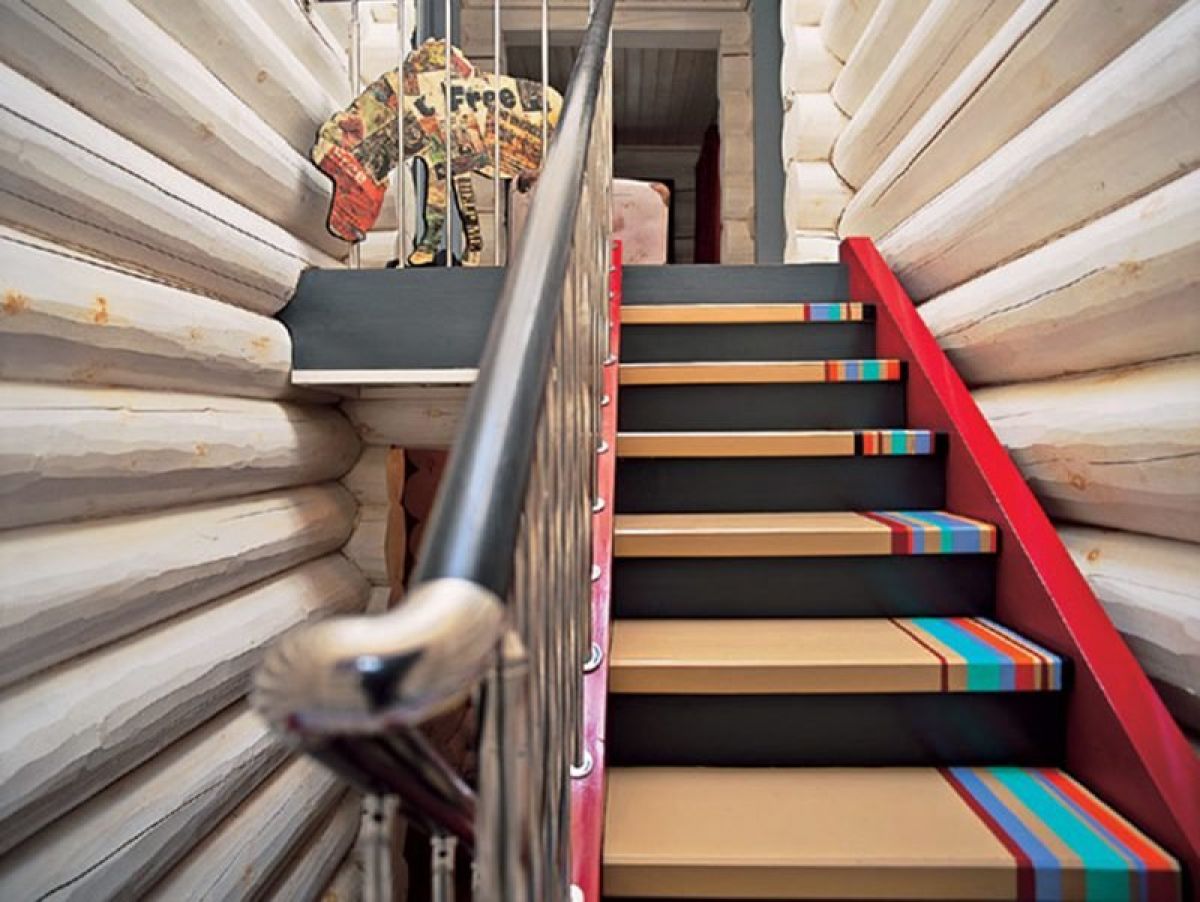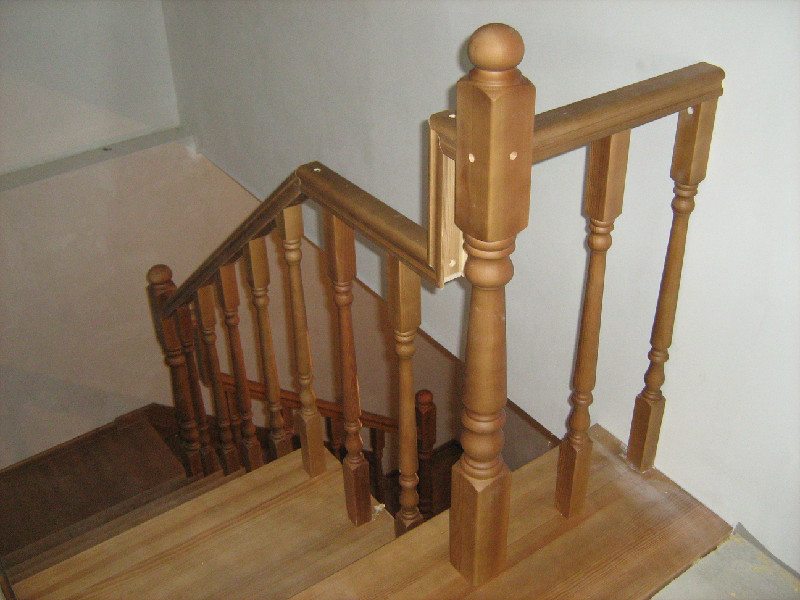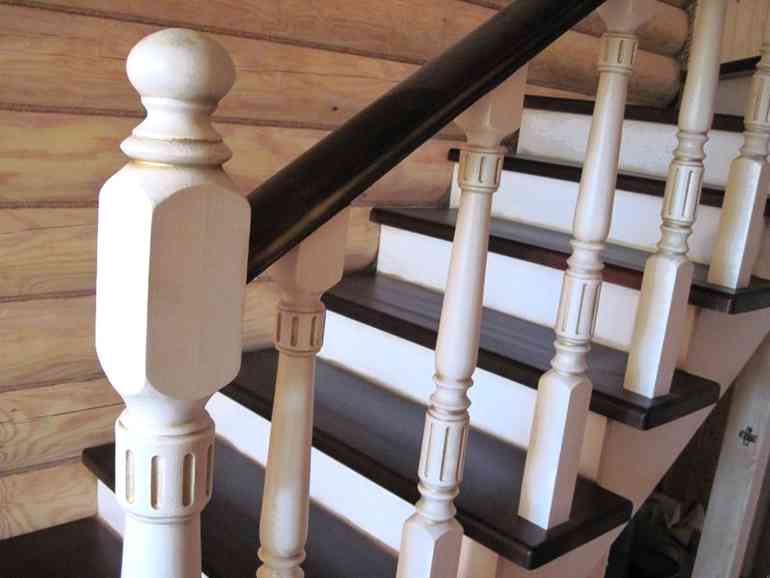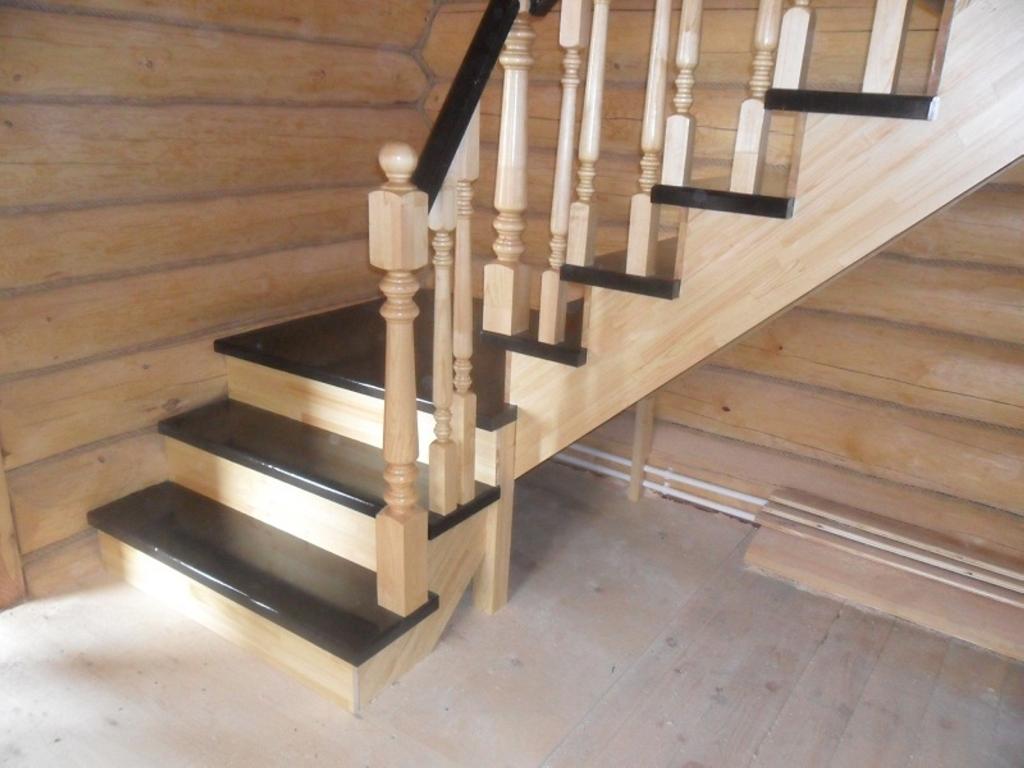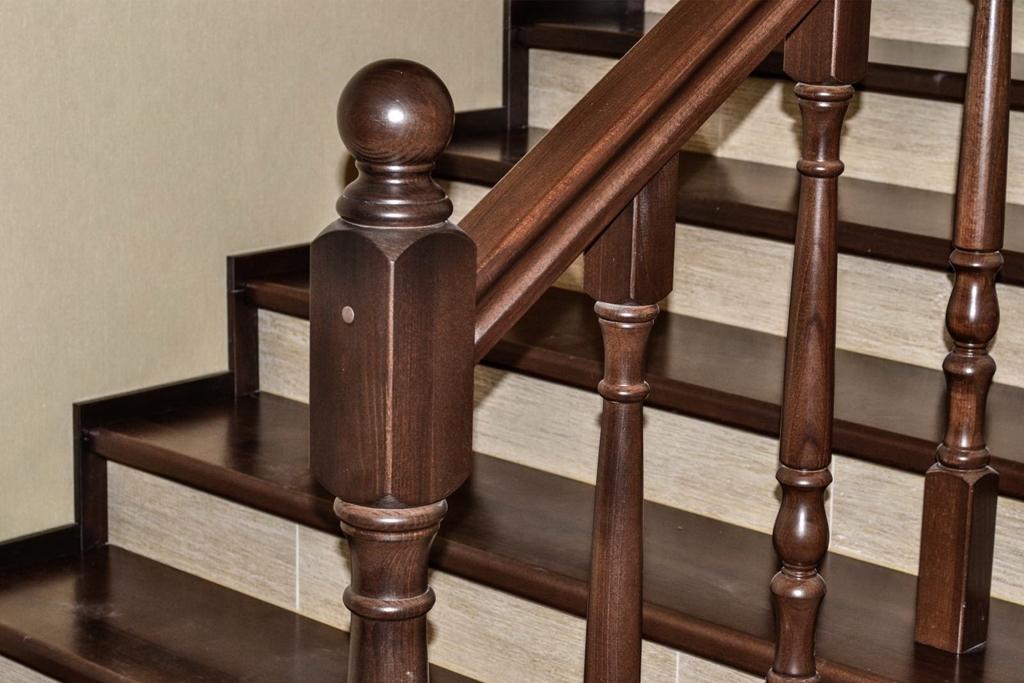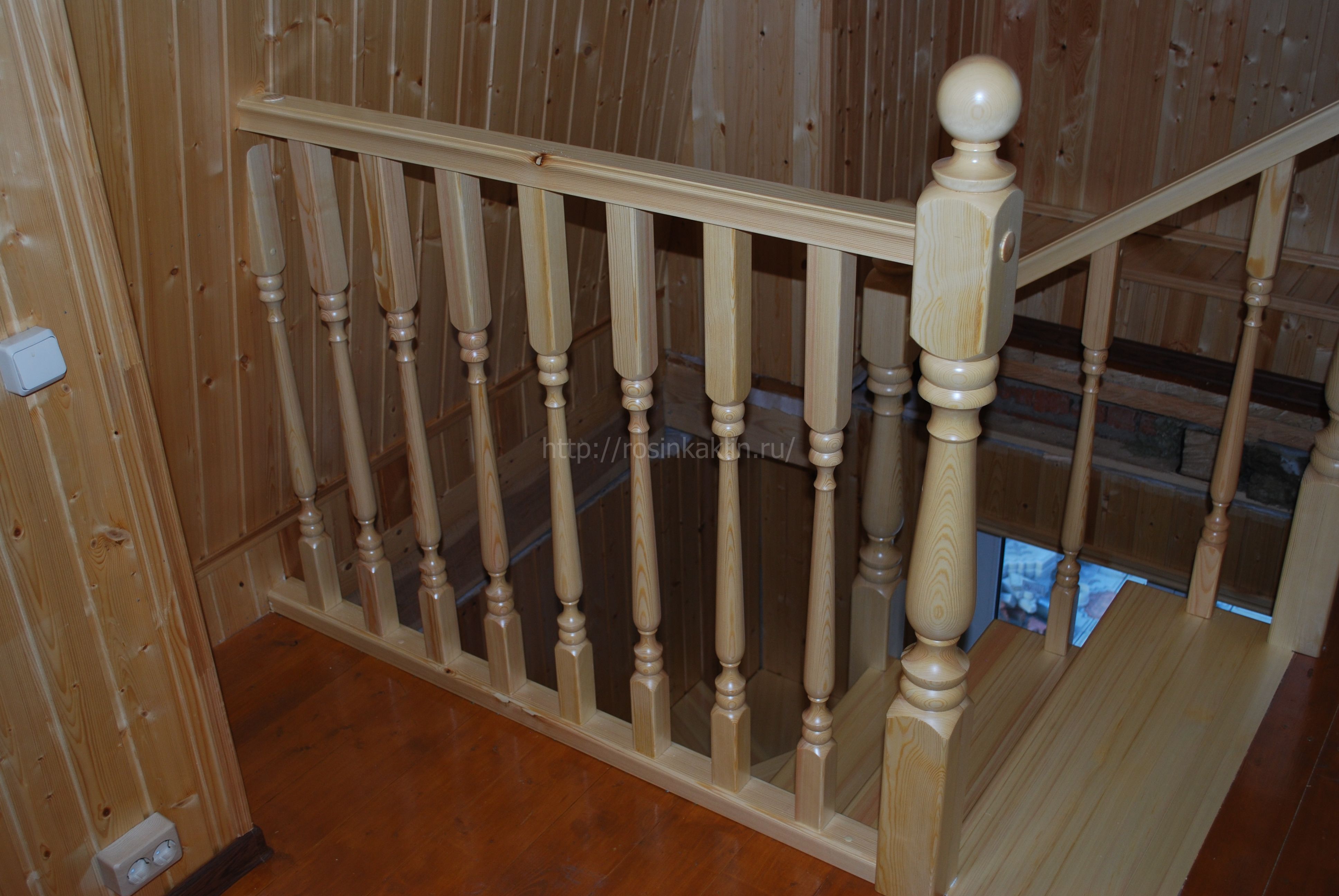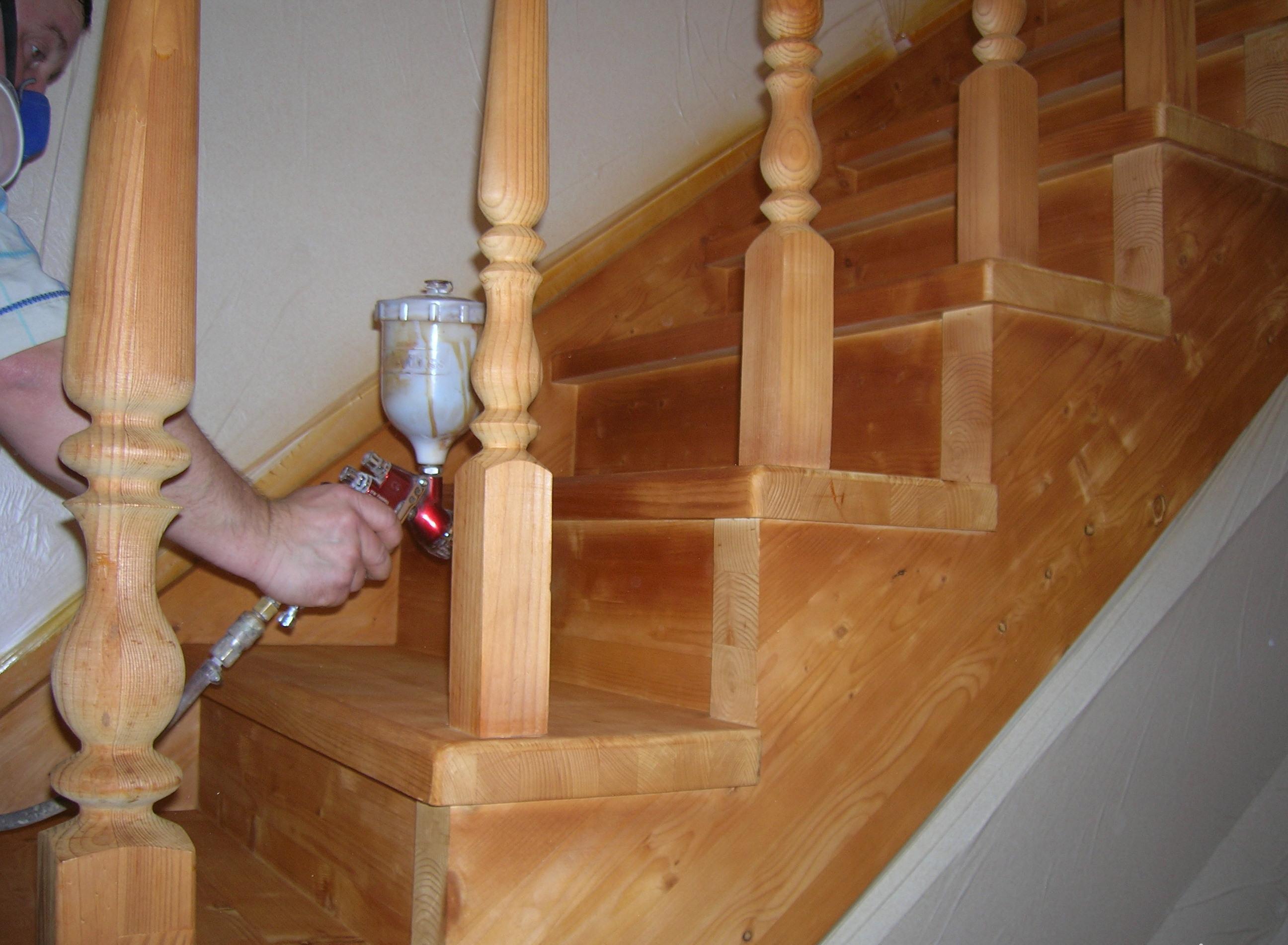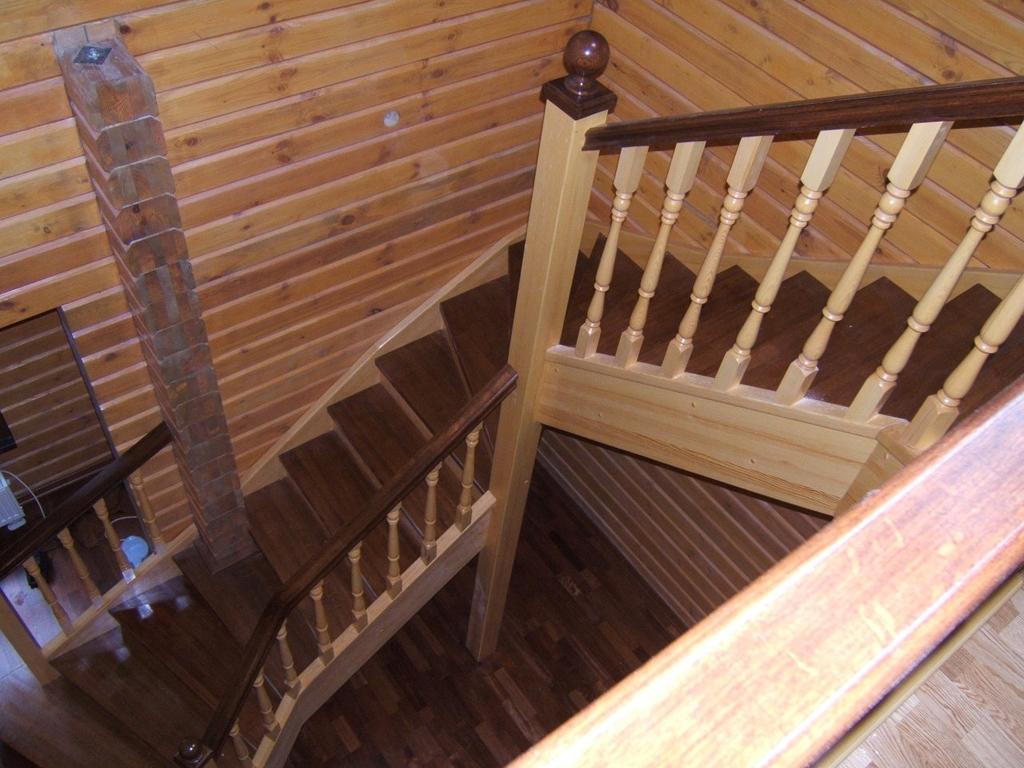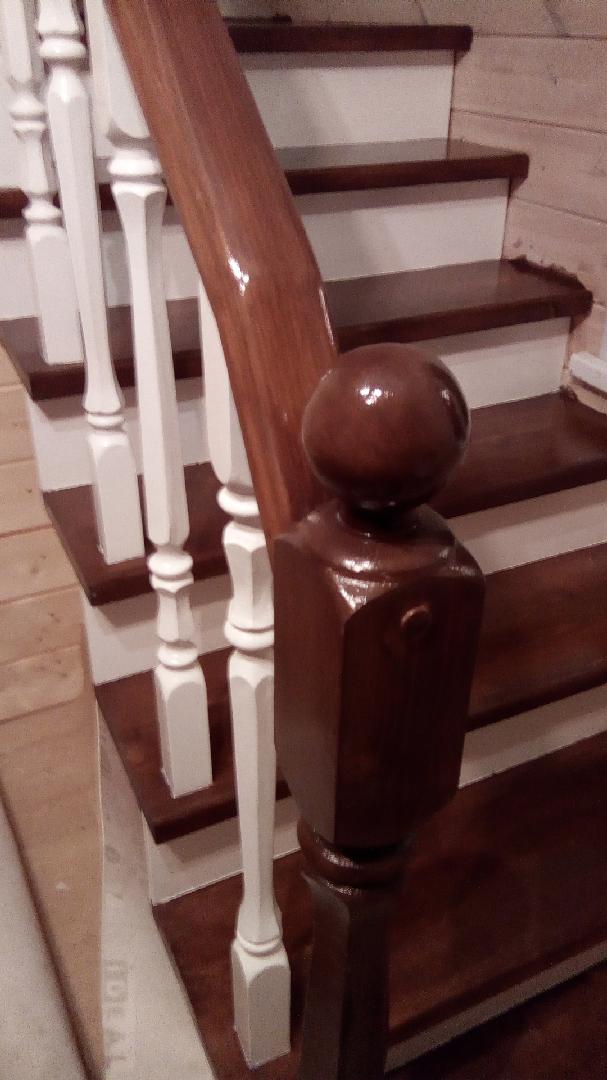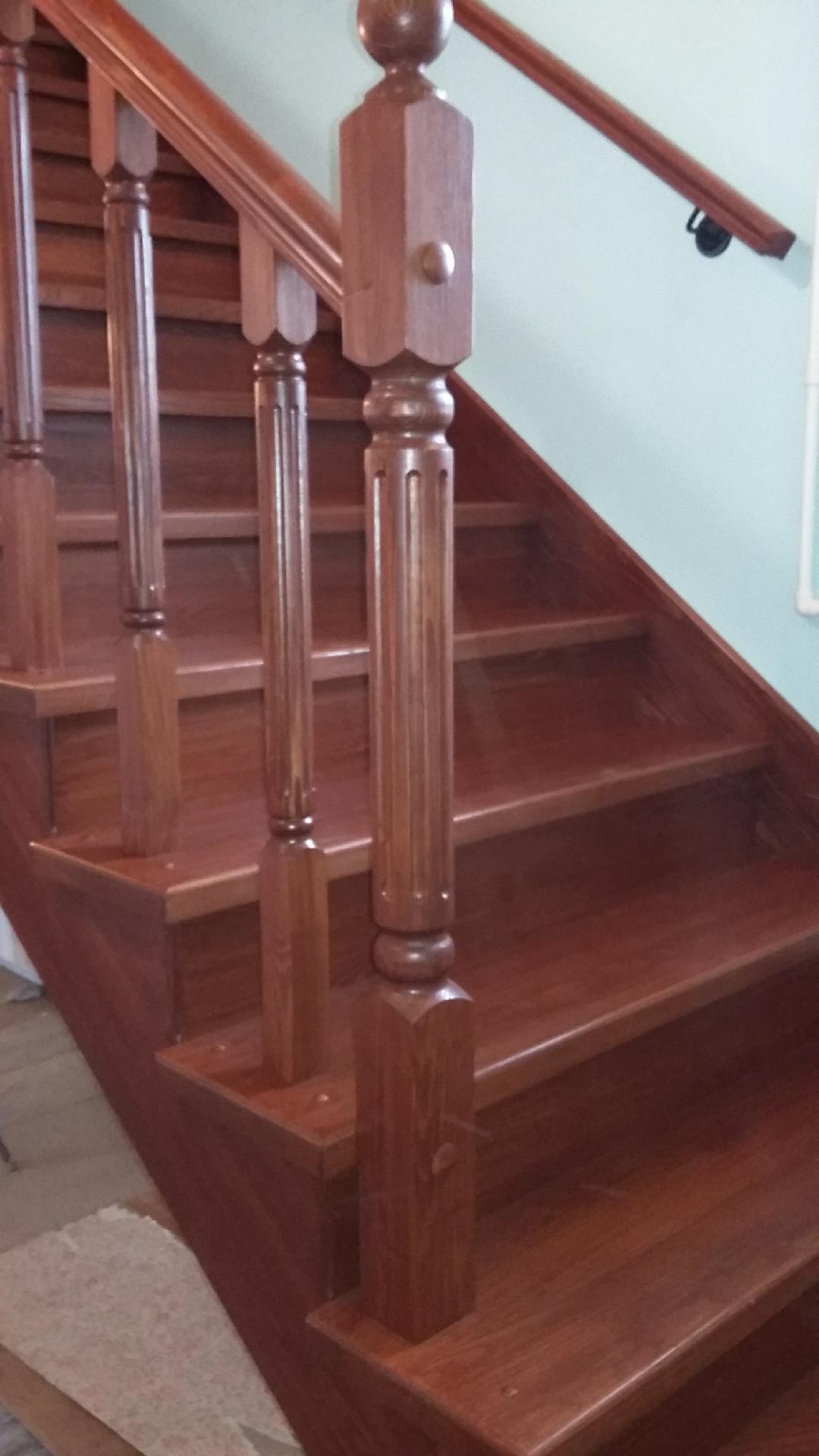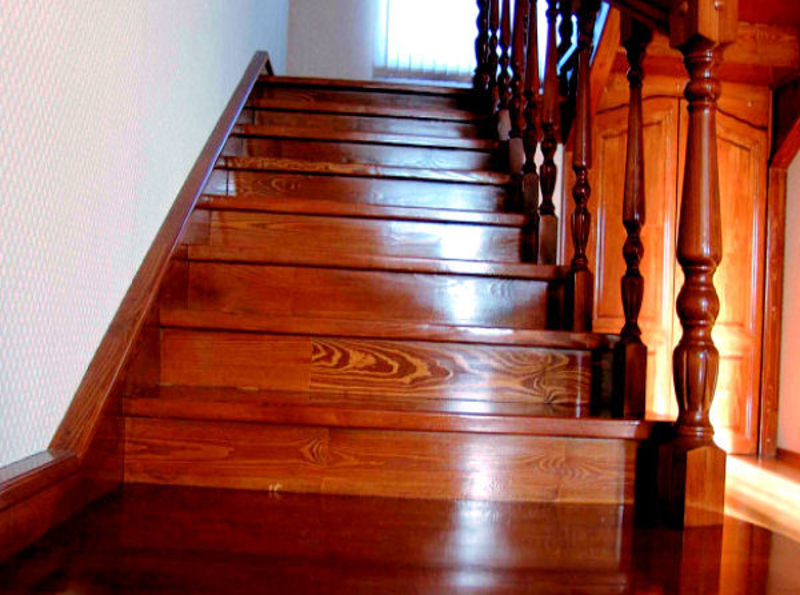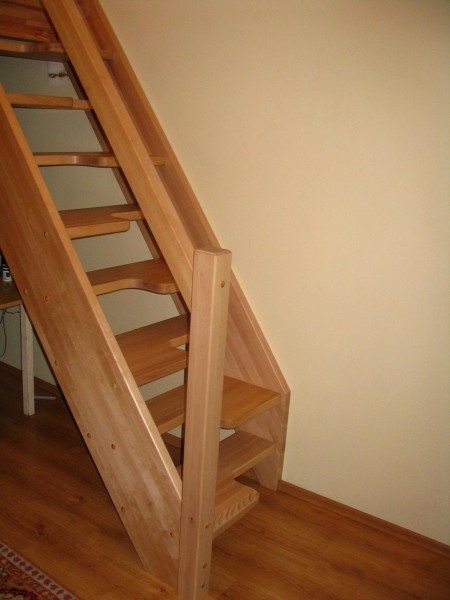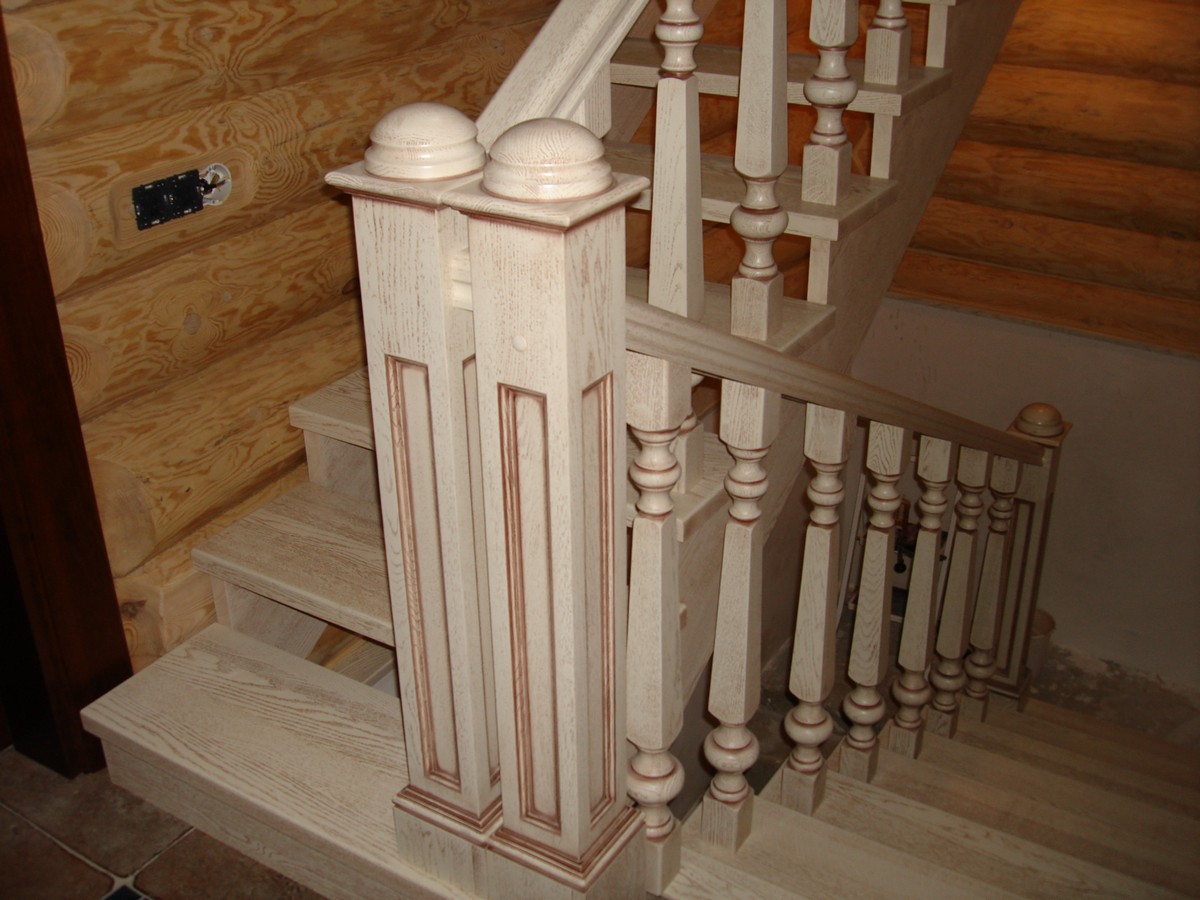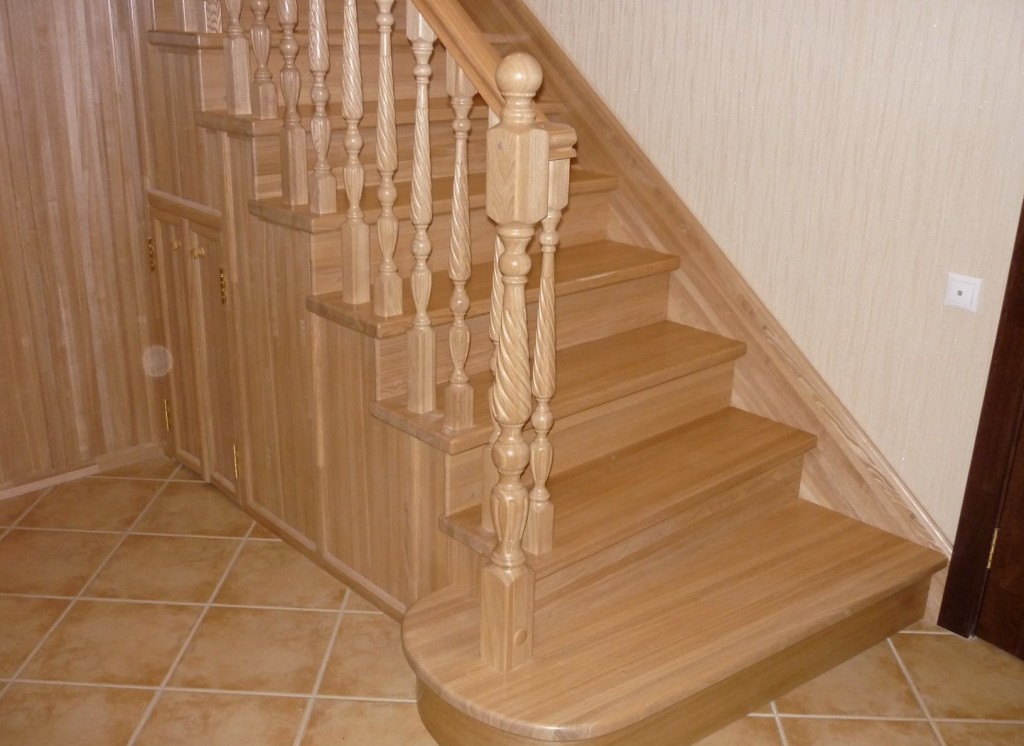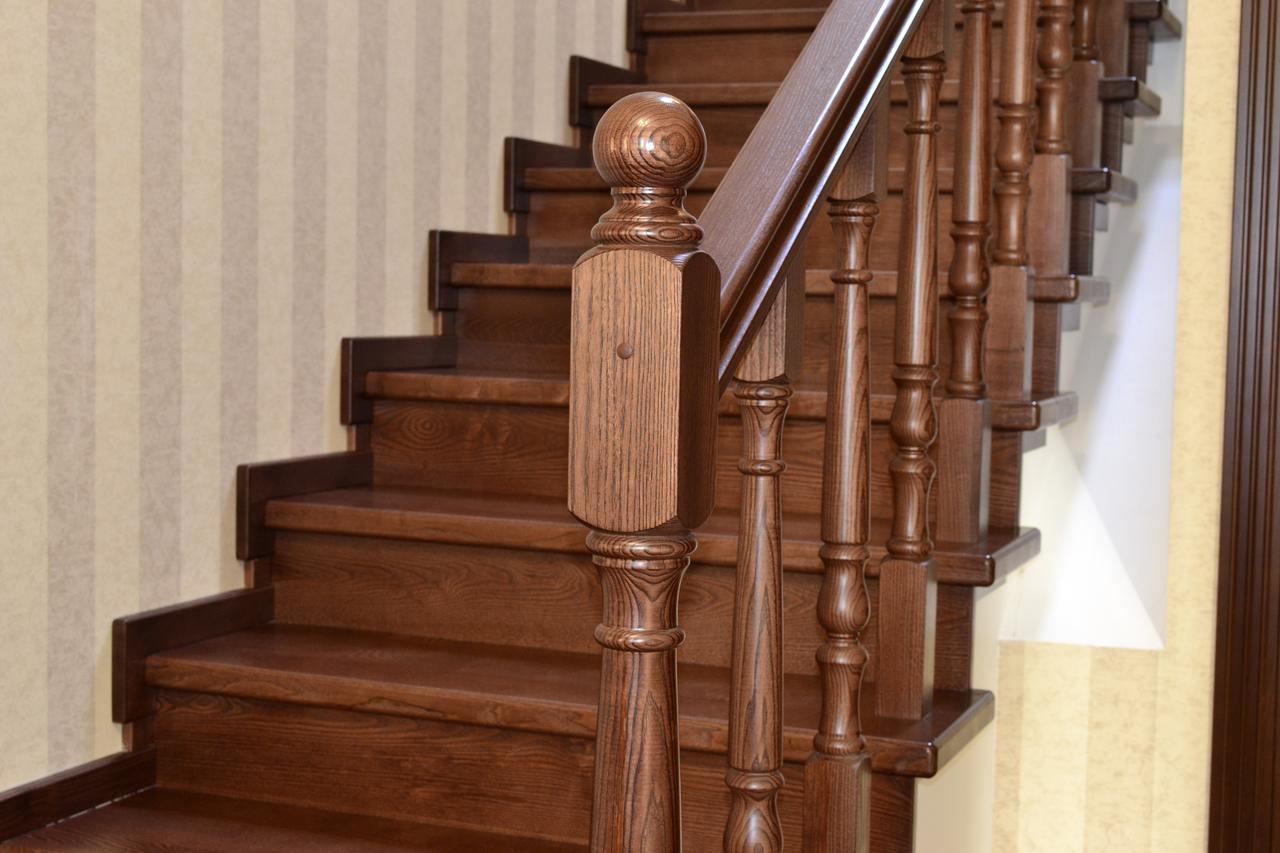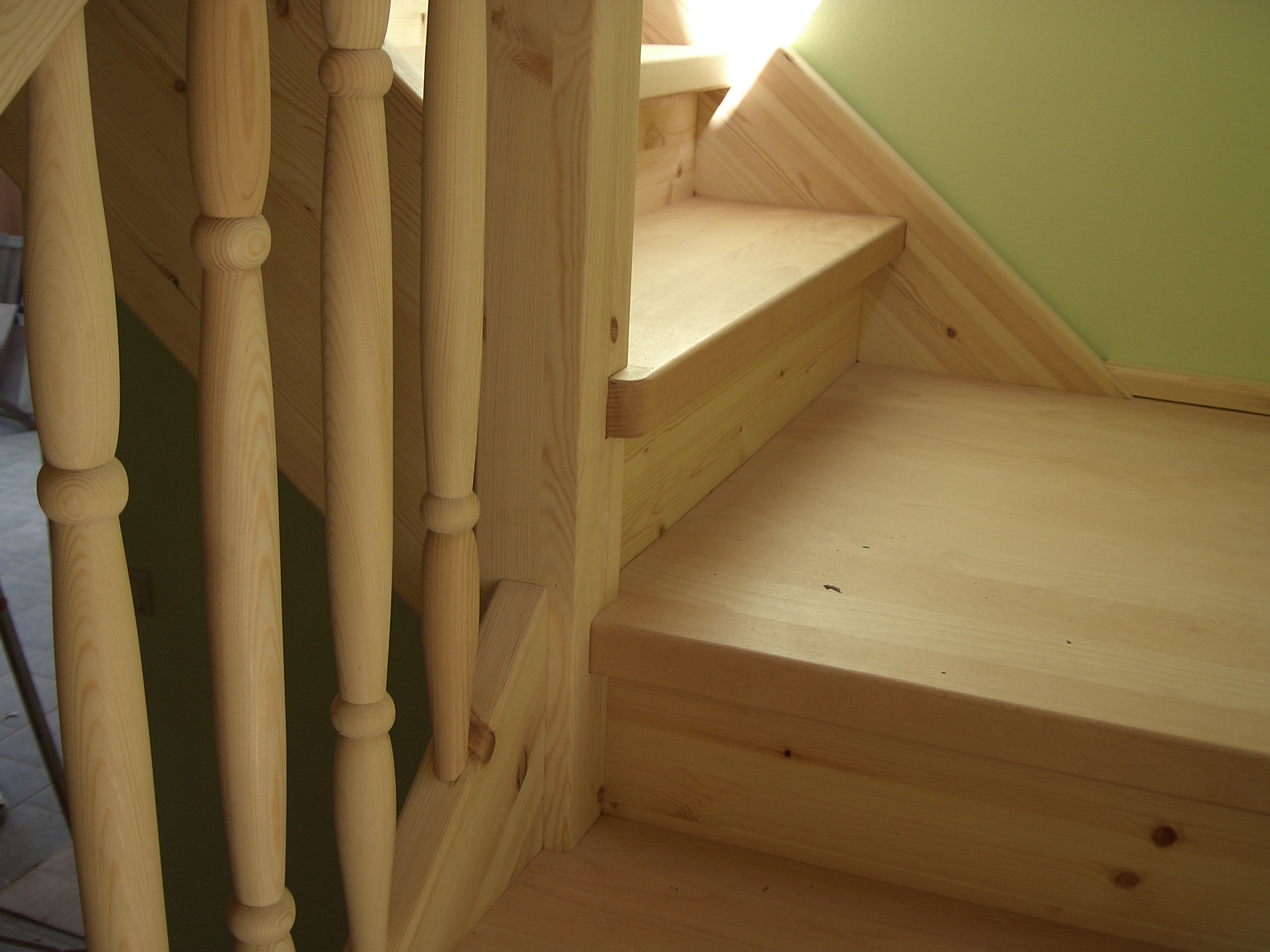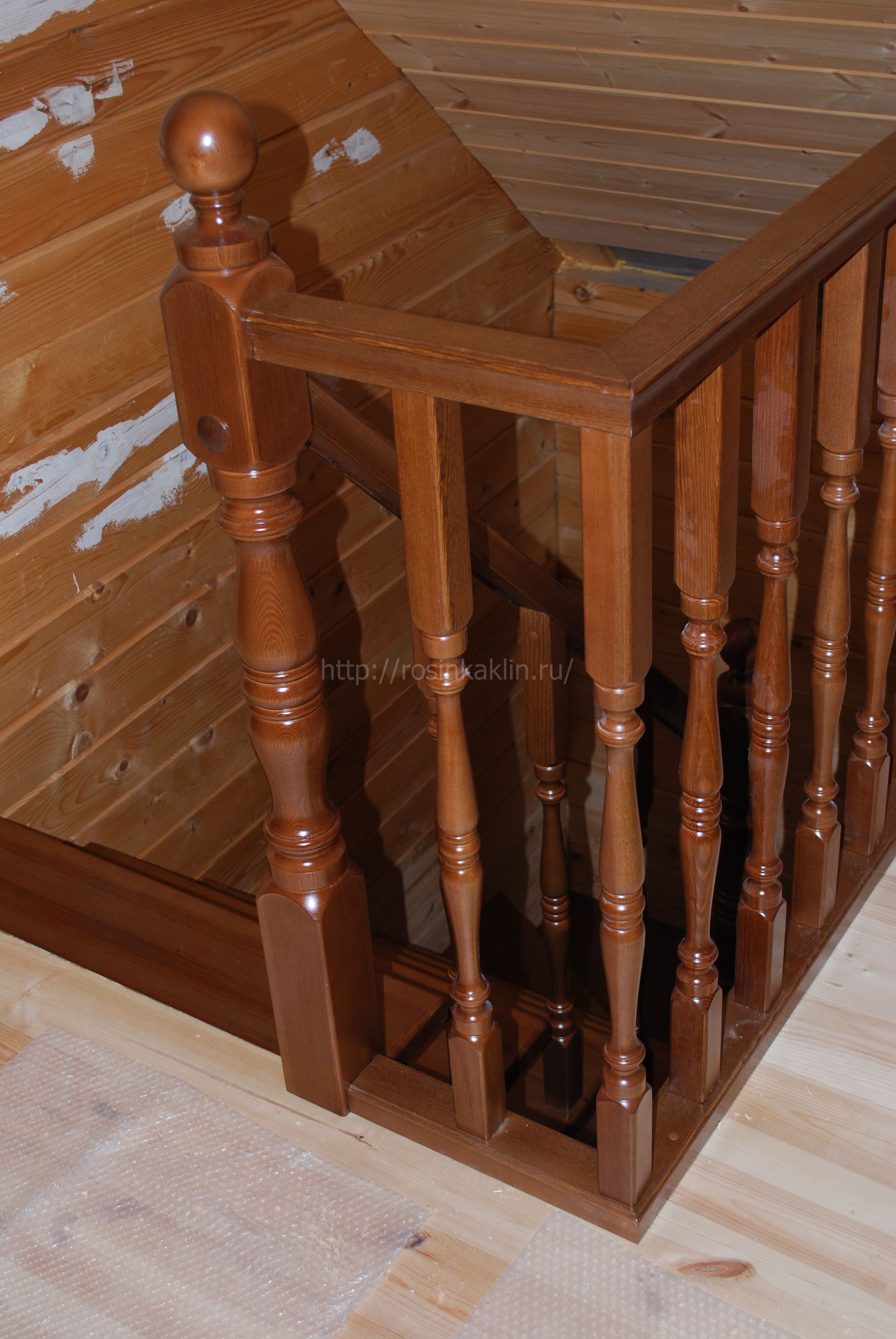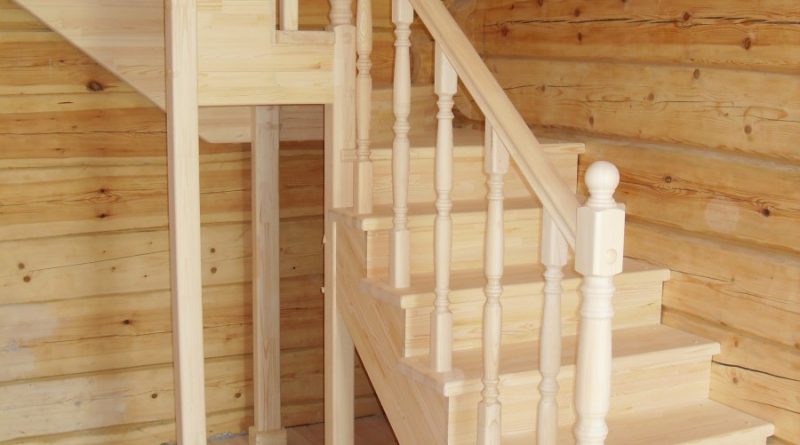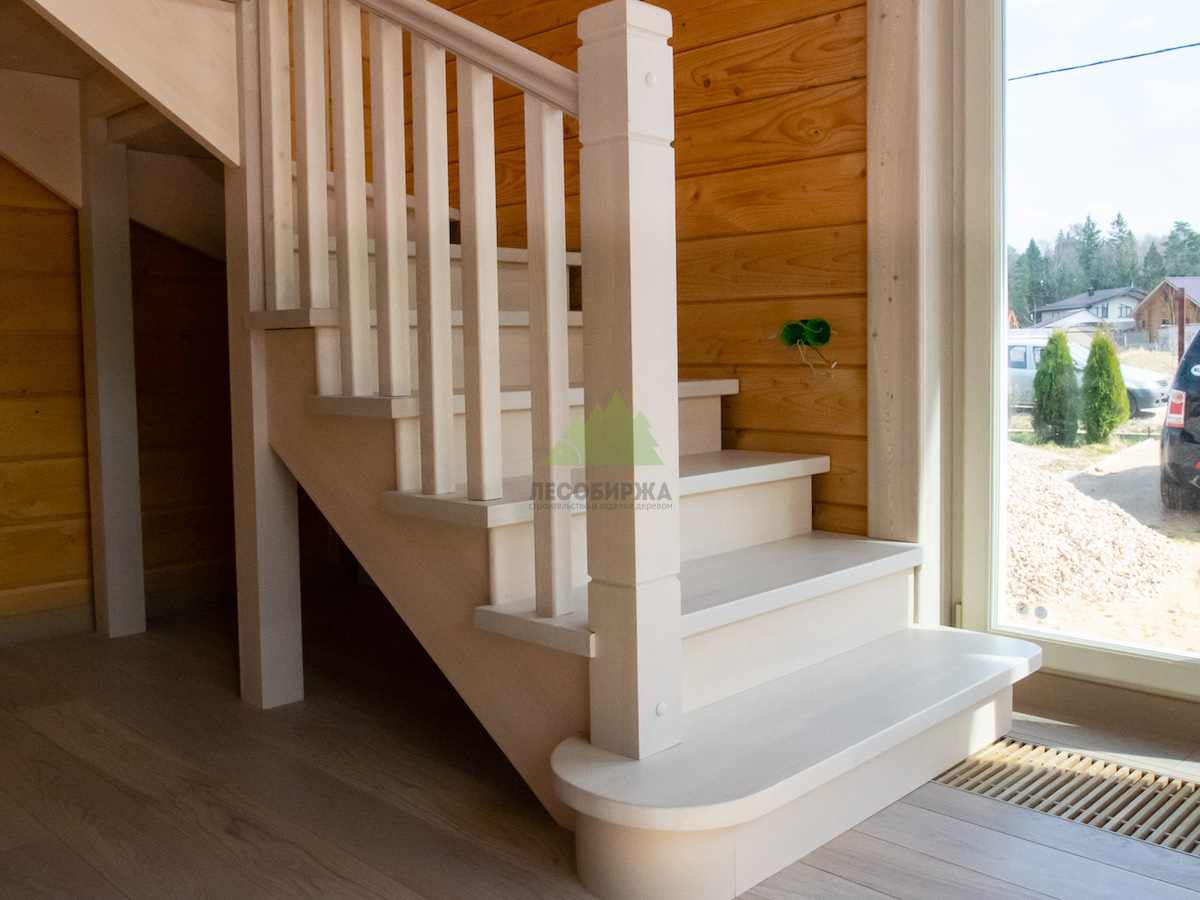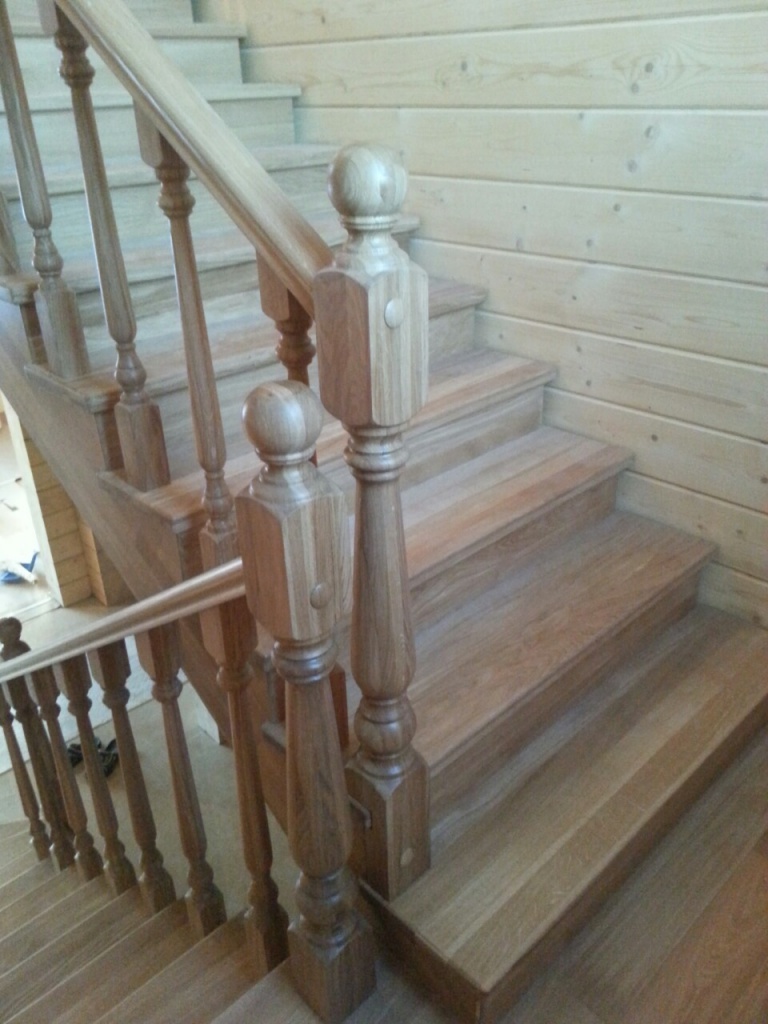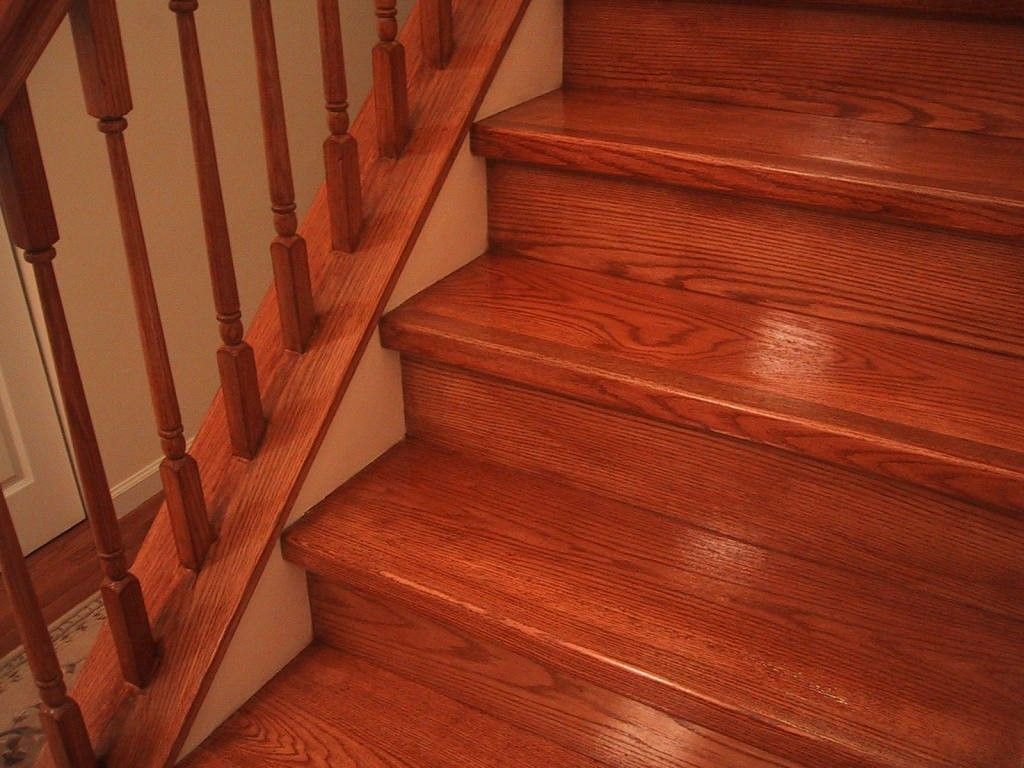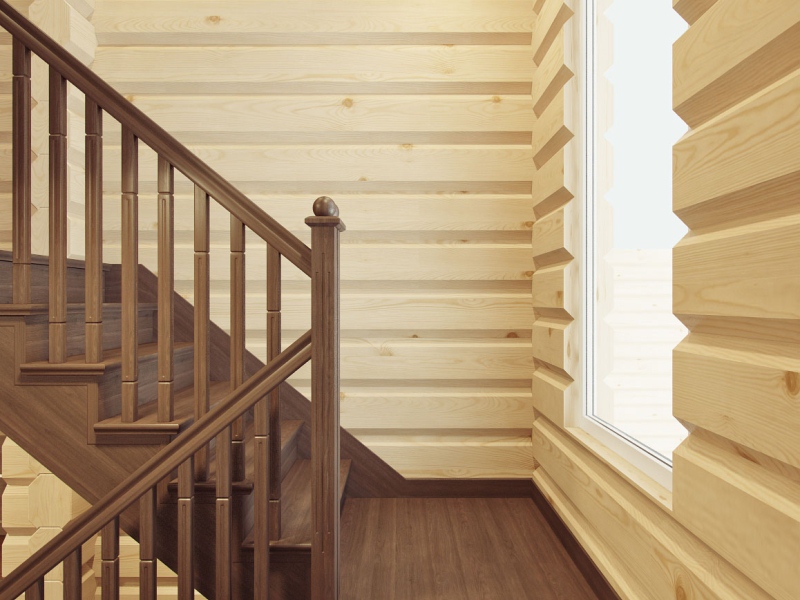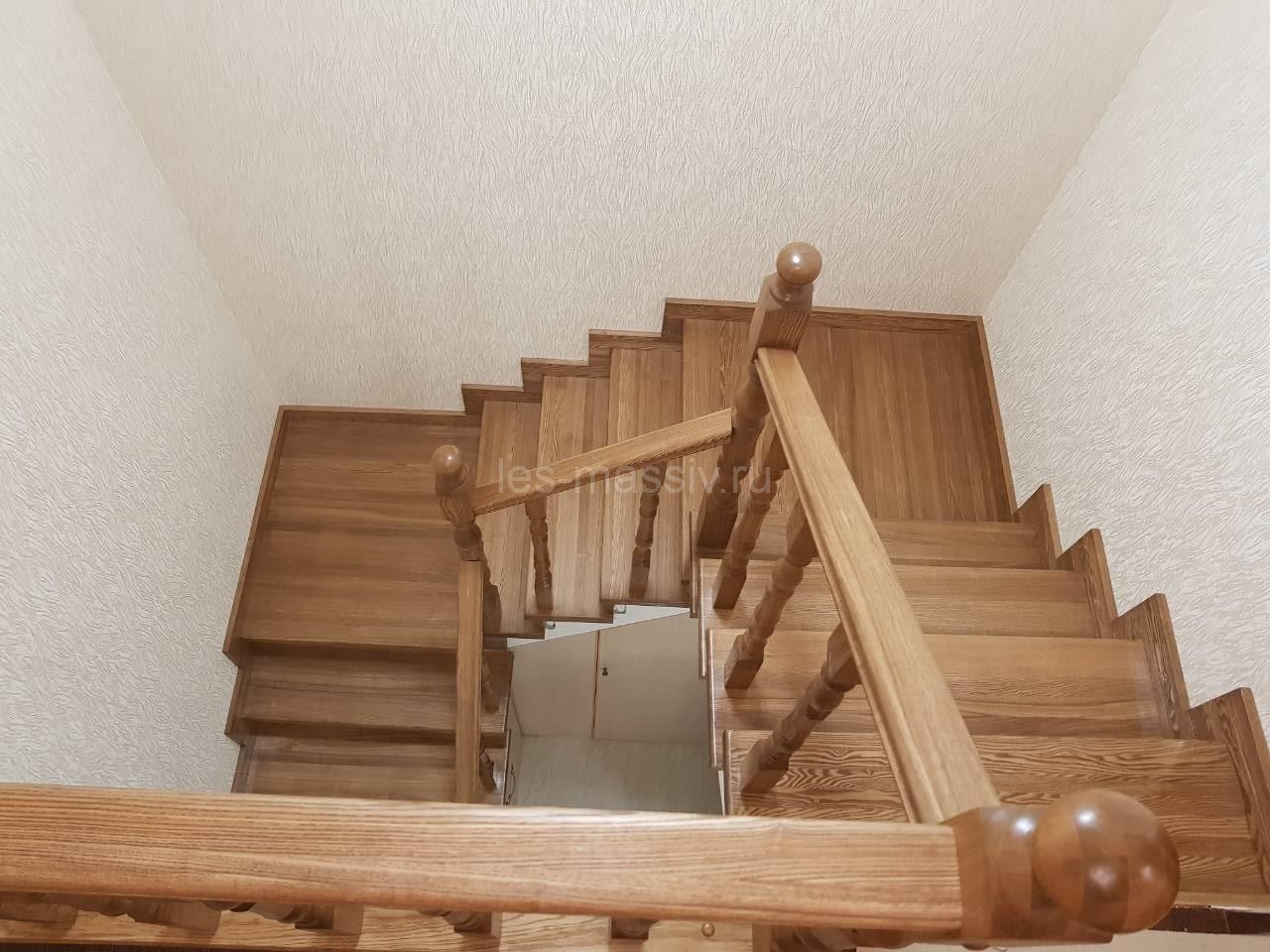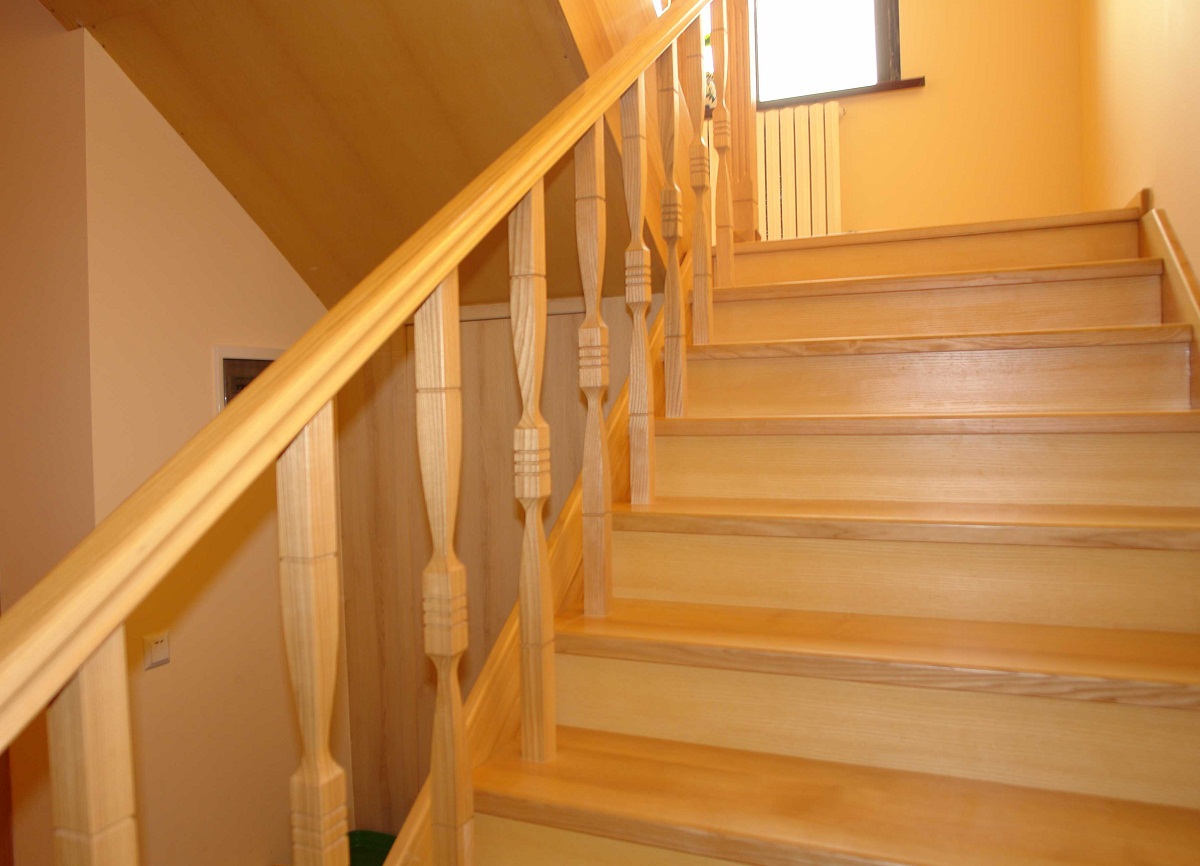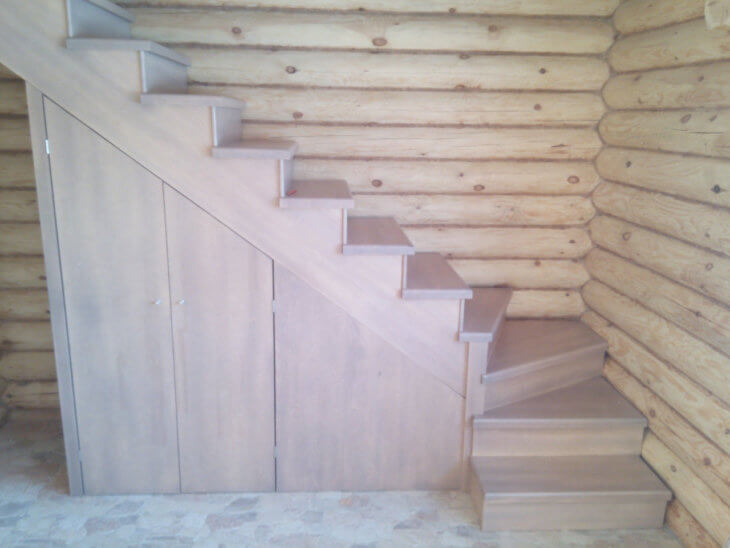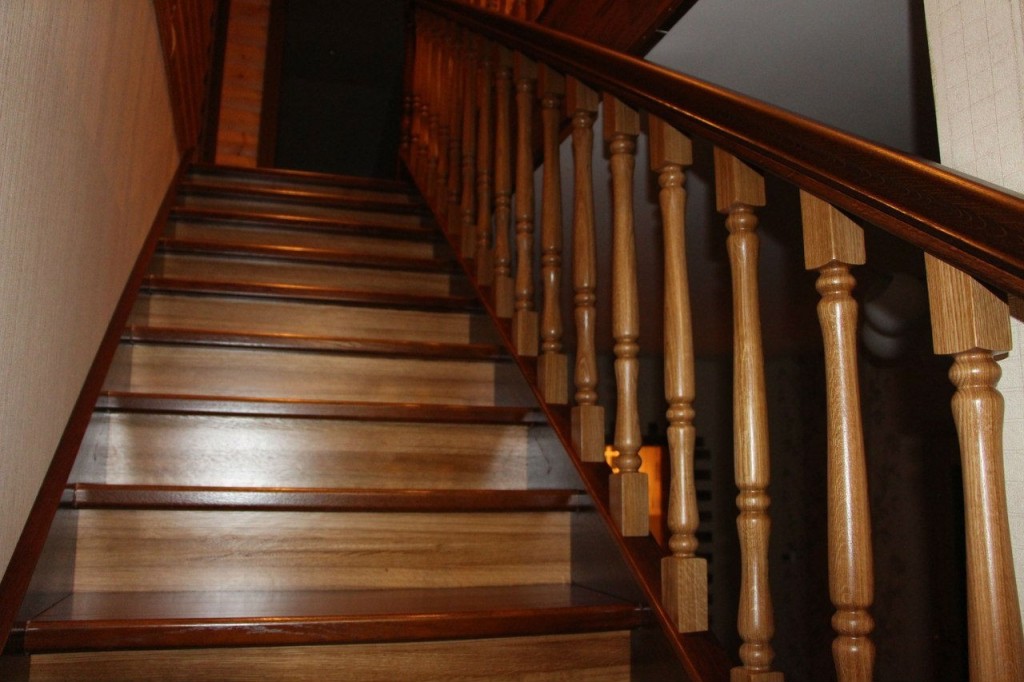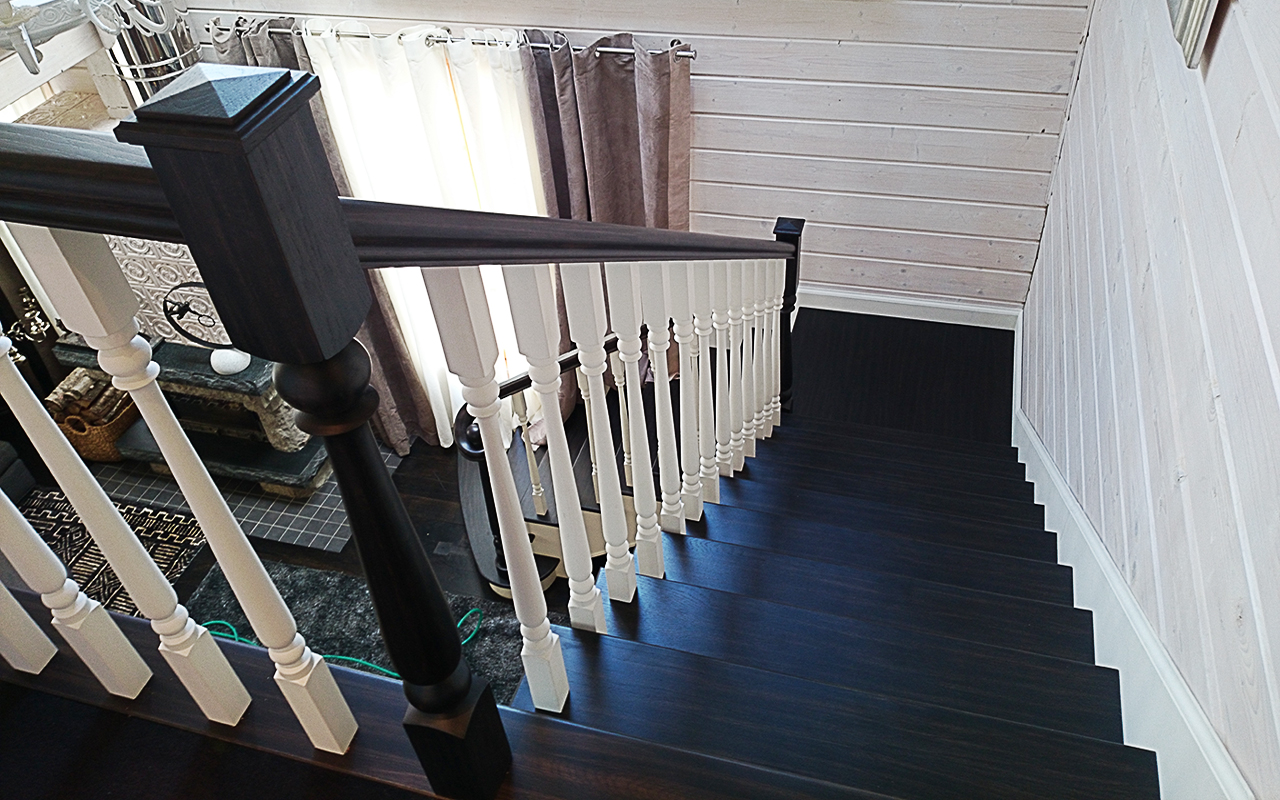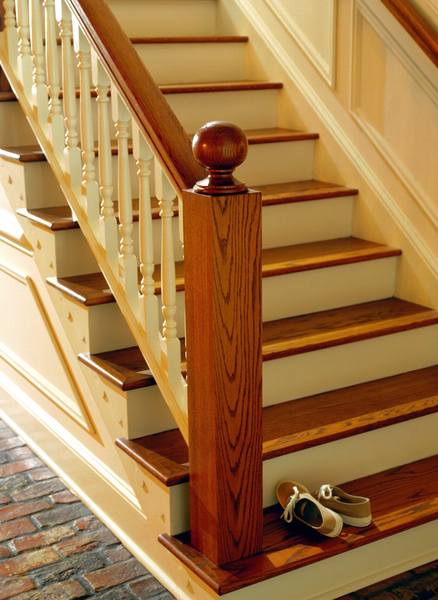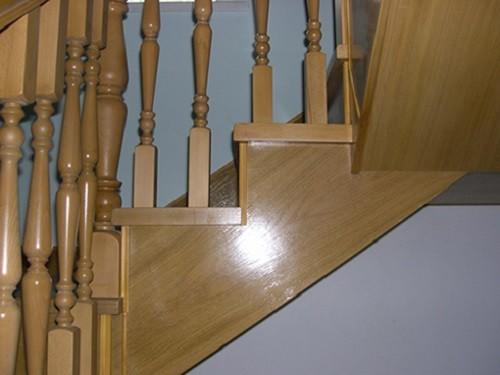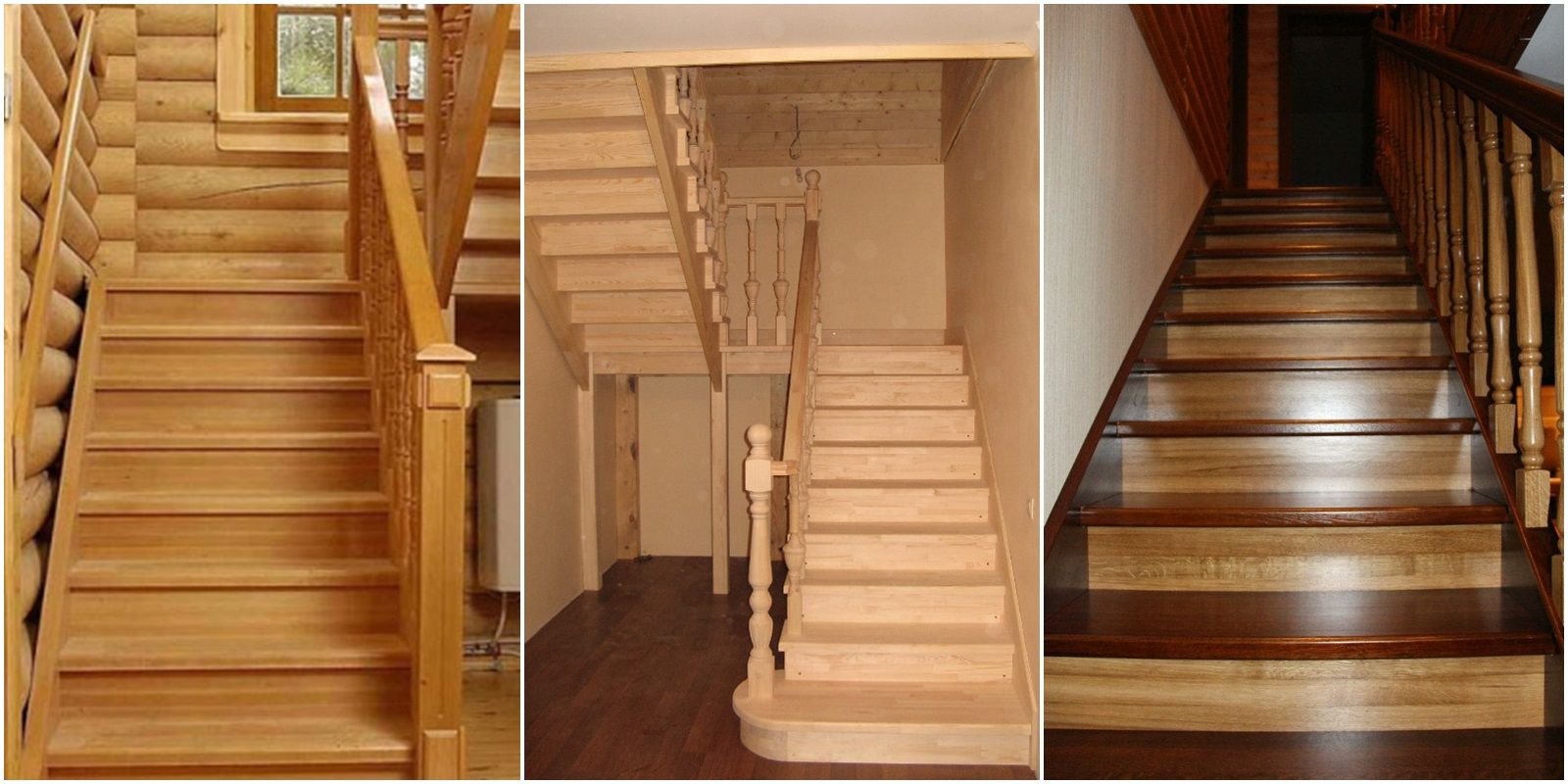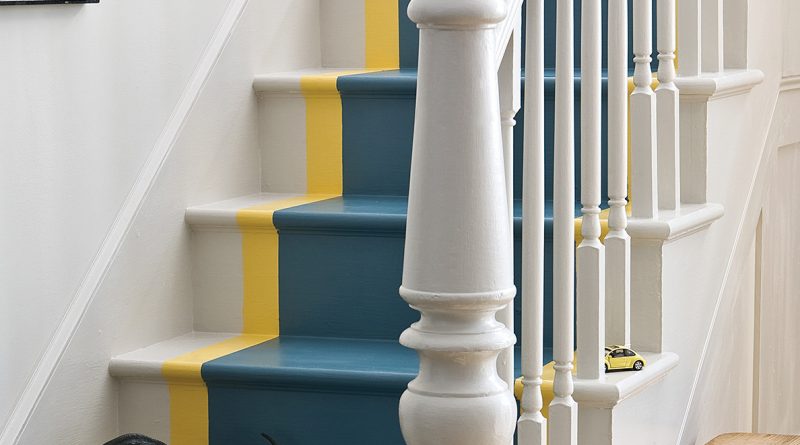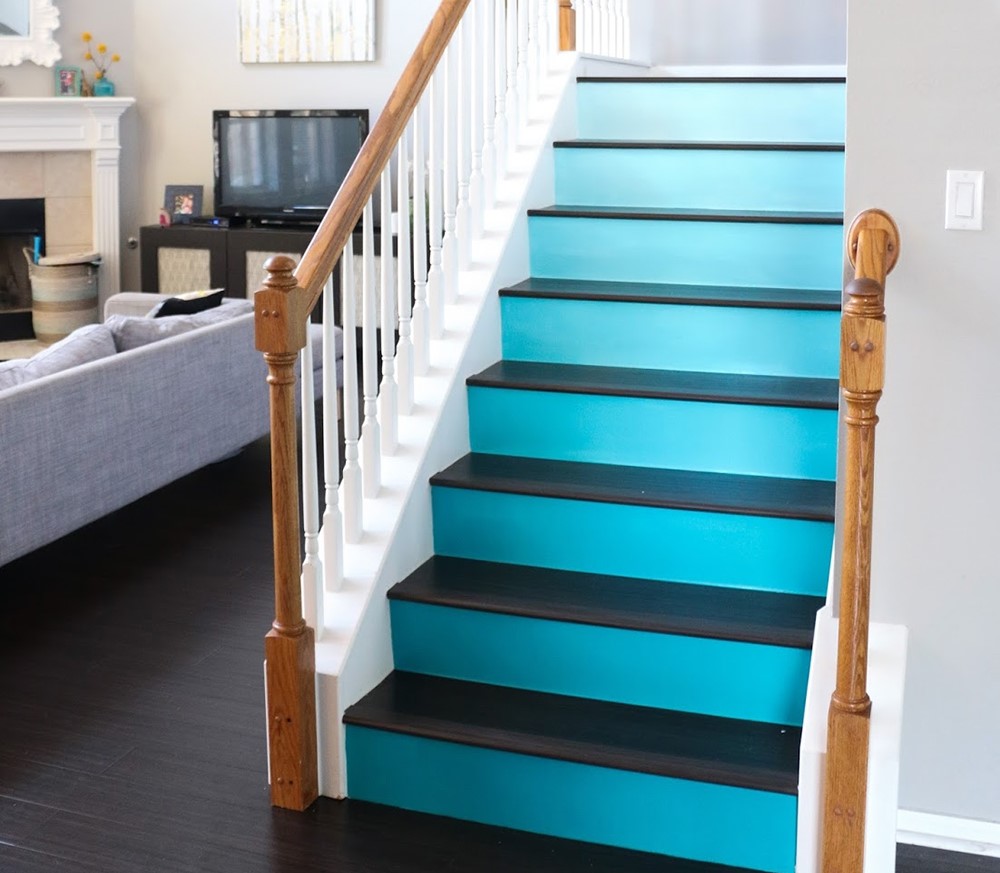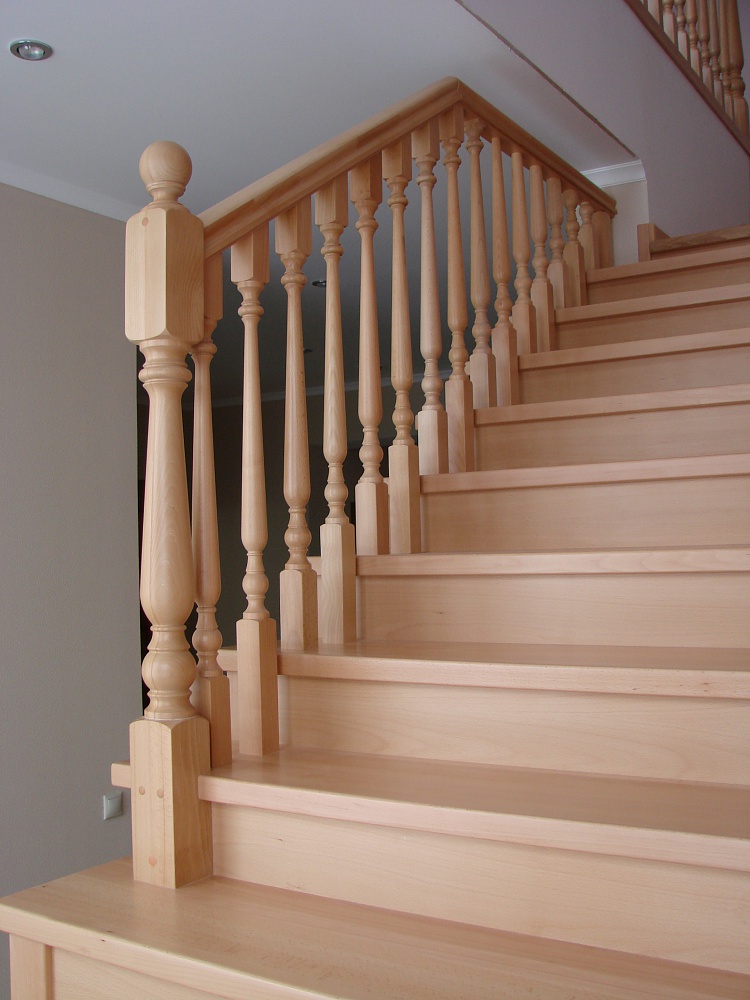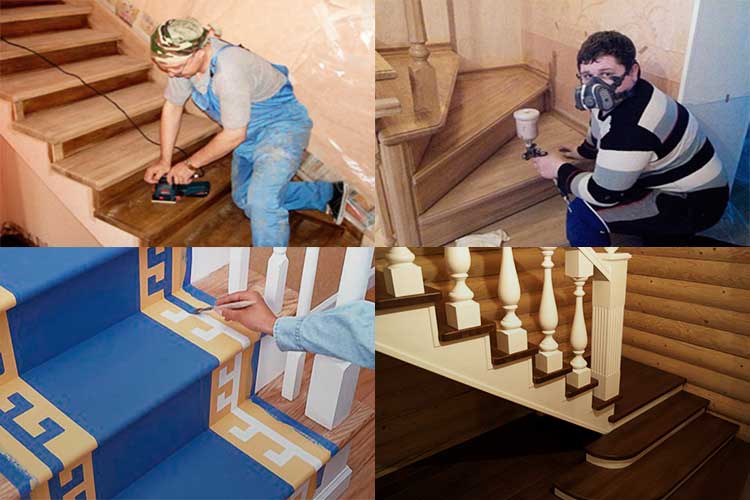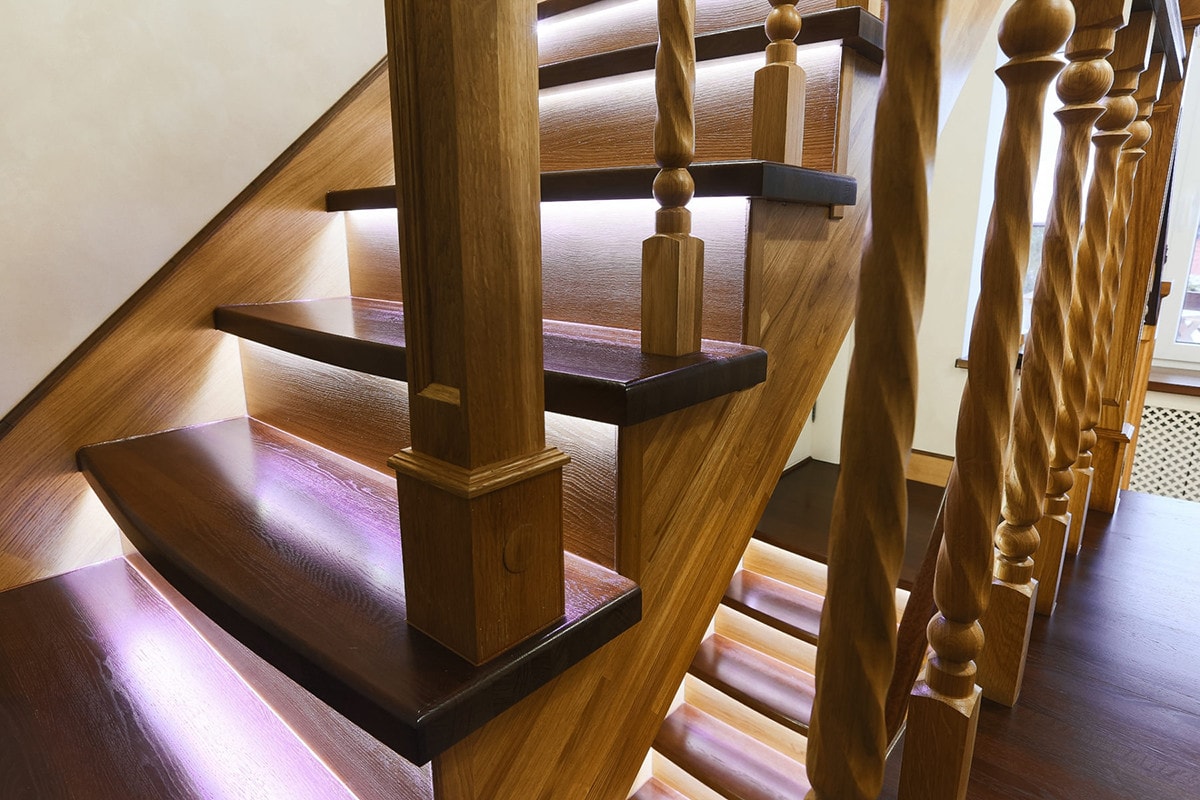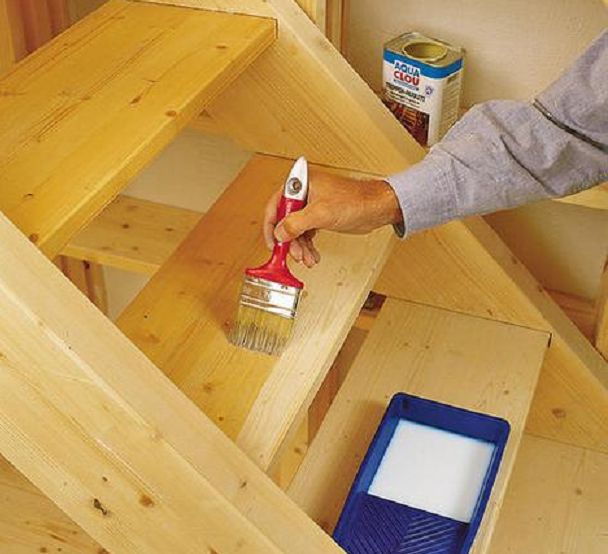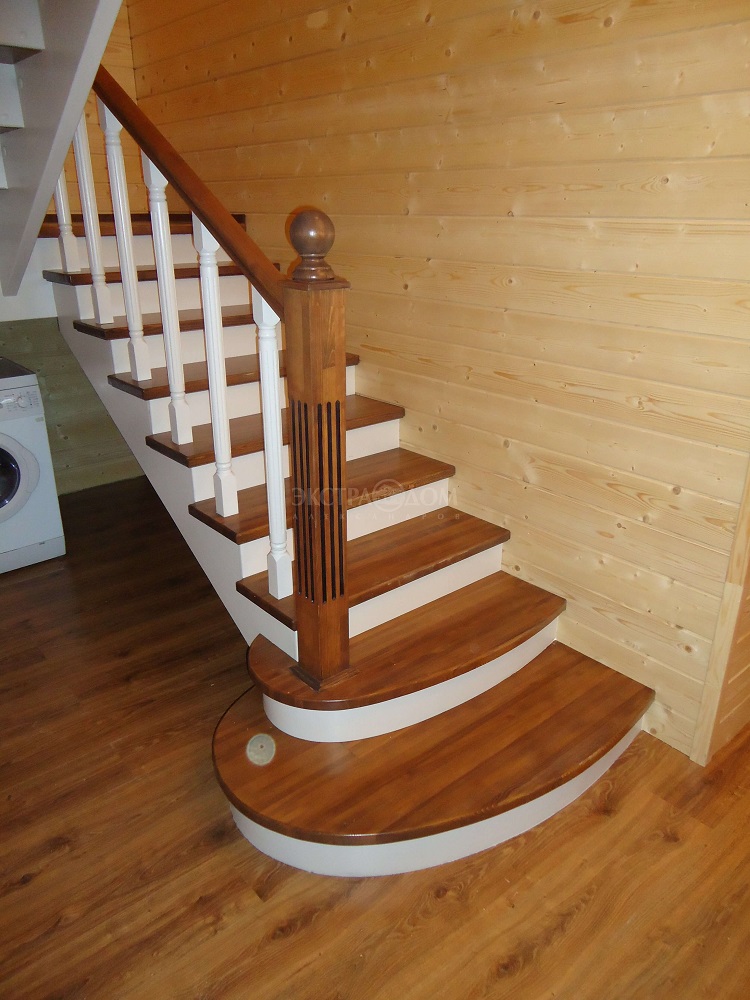Work technology
Wood to wood - strife
If you contact a specialized company to find out the cost of painting a wooden staircase, you will be unpleasantly surprised at a fairly solid amount. That is why many of our compatriots have a desire to do the work with their own hands - especially since it does not present any particular difficulty.
First, you need to pay close attention to the wood from which the staircase is made:
- Conifers (spruce, pine, cedar) are distinguished by a high content of resinous substances, and therefore the paint on them holds somewhat worse.
- Hardwoods are characterized by sufficient density, and therefore it is easier to prepare them for painting.
- Fresh wood has a large number of open pores, which leads to abundant absorption of liquid components of varnishes and enamels.
- Old and dense wood should be primed with high quality, otherwise the paint will simply flow down the stairs.
Preparing the stairs for painting
In any case, in order for the paint to lie flat and hold securely, the stairs must be carefully prepared:
At the first stage, we fill in all the cracks with putty into which the paint can flow. For best results, use a special wood mixture. (see also Oak stairs - manufacturing and assembly features)
Advice! So that the putty spots are not visible through the varnish, its shade should be selected as close as possible to the color of the wood.
After the mixture has dried, we clean the filler with sandpaper in such a way that a perfectly flat surface is obtained.
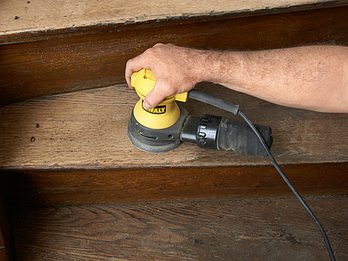
Careful sanding will ensure a perfectly flat surface
- Ideally, wait two to three days after the first resurfacing, and then repeat the operation. This will ensure the most complete polymerization of the putty mass.
- After finishing the treatment, we remove dust from the surface, since even the smallest sawdust under a layer of paint or varnish will appear very prominently.
- We prime the stairs with a brush or roller, applying the primer twice with a break of 24 hours.
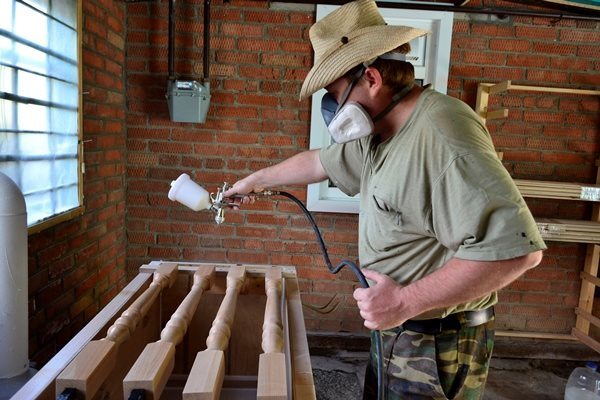
If possible, parts can be processed separately
Painting the stairs
Painting of wooden stairs begins after the second layer of primer is completely dry.
Before starting work, mix the paint thoroughly or dilute the tinting component in a transparent varnish (how to do this - the instructions from the manufacturer will tell you).
Apply paint with a roller on the flat part of the steps
To apply the paint composition, you can use:
- Brushes - wide, with natural or artificial bristles.
- Rollers.
- Sprayers for paint.
- Spray guns.
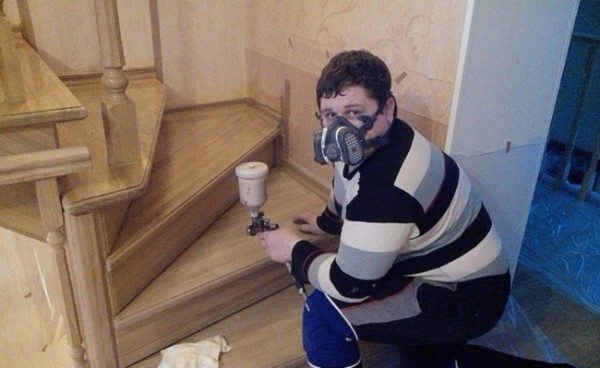
You can use a spray bottle
Below are some tips for using the brush, as this method is the most accessible:
- We start painting from the largest areas in terms of area - railings, steps, stringers, etc. It is also worth moving from top to bottom, making sure that the flowing paint does not freeze in drops.
- Take a small amount of paint on the brush. We remove the excess by running a brush either along the edge of the can, or along an elastic band specially stretched over the neck.
- Holding the brush at an angle of about 45 ° to the surface to be painted, evenly distribute the paint or varnish.
- For the highest quality coating, you can apply from 2-3 to 5-6 layers. We put each next layer only after the previous one is completely dry.
- When using tinted varnish, apply the darkest mixture to the wooden base. We make the upper layers of the staircase varnish almost transparent - this will give the stairs depth and emphasize the texture of the wood.
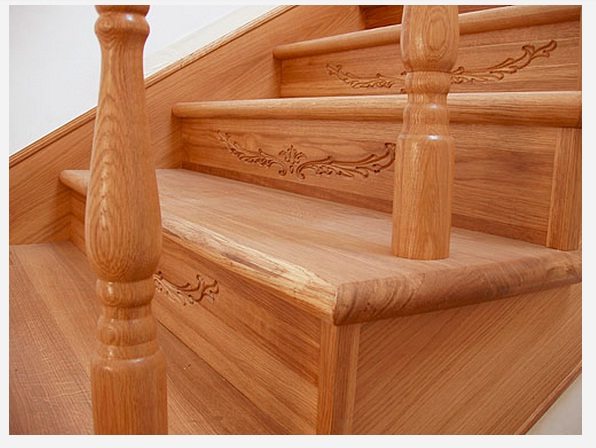
Photo of the varnished surface
The paint should dry at room temperature and normal humidity. Heat or cold will lead to the appearance of microcracks on the surface of the stairs, which will very soon expand and cause the paint to peel off.
We hope that thanks to the information presented in the article, you have learned how to paint a wooden staircase as efficiently as possible. (see also Single-flight staircase: a simple solution) Believe me, such work does not present any particular difficulties, and if you do not rush, then very soon the steps in the house will shine with fresh colors or acquire a noble shine of varnish. In the video presented in this article, you will find additional information on this topic.
DIY staircase painting
Many are worried about the question: how to paint a staircase in a wooden house correctly? To create a beautiful and long-lasting finish, it is necessary not only to choose the right coloring agent, but also to prepare the surface well. A wooden staircase, like any other wooden surface, requires careful preparation.
Preparatory work
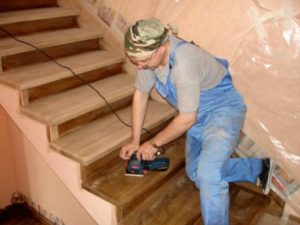
- If the staircase is made of softwood, remove excess resin before painting, which prevents the paint from absorbing. There are special tools designed for these purposes.
- If there is an old paintwork, the ladder must be treated with a remover, and then the swollen paint must be removed with a spatula.
- The main structural elements are sanded first with coarse-grained, and then with fine-grained sandpaper. You can use a grinder with a grinding attachment. Initially, the surface is treated with abrasive No. 60-80, then nozzle No. 120-150 is used. Especially carefully you need to polish the steps, railings and spans - places that wear out and lose their appearance faster than others.
- After cleaning the surface from wood dust, it is necessary to putty all existing cracks and cracks. It is advisable to choose the putty to match the color of the wood. If the gap is deep enough, you can close the hole with a piece of wood previously greased with PVA glue.
- Next, the final polishing is done with fine sandpaper. After sanding, you should get a perfectly smooth surface without knots and unevenness.
- A primer is applied to the treated and cleaned surface with a roller or brush. A day after the first layer has completely dried, the staircase is re-treated with an antiseptic soil.
Staining stairs
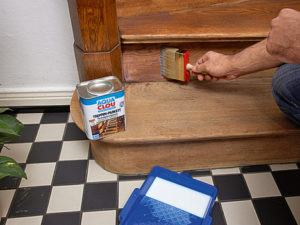
The stairs are painted from top to bottom. First, large areas are painted - steps, railings and stringers. If you need to use it, you can first paint not all the steps, but after one, and after drying, paint the rest.
Stir well before applying the dye. If the paint is very thick, it can be thinned a little with solvent.
Thick paints adhere better with bristle brushes. Liquid products are best applied with flakes. When painting with a brush, it must be held at a 45 degree angle to the surface.
The staircase is painted in 2-3 layers. In some cases, a high-quality coating requires at least 5 coats. A new layer is always applied after the previous one has completely dried.
What can and should be used to cover a wooden staircase
When you enter a building materials store, you start to get lost
Therefore, it is important to know not only the types of these products, but also their features. The most common options for paintwork materials for painting stairs are:
- dye;
- varnish;
- impregnations and stains;
- butter.
Paints
Today there are 3 types of them:
- Alkyd. These enamels are non-toxic. Their advantages are that they dry in a short time and protect the wood from fungi and mold due to the presence of antiseptics in the composition. A ladder covered with alkyd paint is not afraid of any mechanical damage. At cost, these dyes are quite affordable and have a wide range of colors.
- Acrylic.Their advantages are the absence of a pungent odor, high drying speed, non-toxicity, long service life, and a wide palette of shades. The acrylic coating does not fade in the sun and allows the material to "breathe".
- Oil. This type of paint for a wooden staircase in a house is not ideal. The advantages include low cost and low expense. The reverse side of the medal is low wear resistance, the presence of harmful substances in the composition, and a long drying time. In general, we do not recommend it.
Lucky
To emphasize the natural beauty of the tree, varnishes are used.
When choosing the appropriate type, pay attention to the features of the material of construction and the conditions of its operation. Lacquer coatings, like paints, come in several varieties:
- Alcohol. This coating protects the stairs from biological and mechanical damage. But its significant drawback is the low degree of moisture resistance. Therefore, it is better to use it as a base coat to give the wood the desired shade.
- Alkyd and alkyd-urethane. They are used for external and internal structures. A hard transparent film with a subtle tint serves as a reliable barrier against moisture and other negative factors.
- Formaldehyde. The structure will become more resistant to wear and tear. The resins included in the composition improve the adhesion of the varnish to the wood. The only drawback is toxicity and a characteristic odor, which quickly disappears, but requires wearing a dispenser during application.
- Polyester. After curing, they form a hard, durable film that protects the stairs from moisture and other negative influences. If you want to make your design shine, use a polyester varnish.
- Epoxy. These are two-component solutions that are used with hardeners. They prevent the destruction of the structure under the influence of moisture, alkalis and provide it with mechanical strength.
- Polyurethane. They are distinguished by a high degree of wear and resistance to mechanical stress. The high price of varnish is justified by its long service life and high performance characteristics.
- Yachting. The hard and durable lacquer coating has good elasticity. This means that when the structure is deformed, the varnish layer does not flake off or crack. Due to its composition, yacht varnish is distinguished by wear resistance, good resistance to fungi, increased resistance to UV rays, and moisture resistance.
Stains
This type of impregnation is characterized by antiseptic properties. On top of the stain, varnish is often applied as an additional layer
But at the same time, you need to pay attention to the compatibility of these funds.

For stairs made of wood, impregnation with an oil or wax base is best suited. Sometimes a dye may be part of the stain, which gives the material a certain color.
Material selection rules
In the huge variety of paints and varnishes that manufacturers offer today, there are several materials suitable for painting wooden stairs. These are various varnishes, stains, impregnations and paints that are easy to apply with your own hands using a roller, brush or spray.
Lucky
Varnishes are most often used for processing wooden structures, because they do not cover the wood pattern, which is very important when decorating the interior of rooms. To determine which varnish is best for processing a wooden staircase, consider their main types
Oily products are a mixture of resins (artificial or natural) with vegetable oils. Not the best option, because it has low wear resistance, but cheap.
Alcohol varnishes are a solution of resins with alcohol. In the process of application, the alcohol quickly evaporates, leaving a sufficiently strong layer of resin on the treated surface.The lacquered surface is easy to polish, but has a low water resistance. Such compositions can be used to paint balusters.
The production of alkyd varnishes is based on alkyd resins dissolved in white spirit or other organic solvent. They have high wear resistance, increased strength, they are not afraid of changes in temperature and humidity. So they can be safely used when processing outdoor stairs.
Epoxy varnishes are characterized by high mechanical strength, water-repellent properties, and inertness to alkalis. Two-component formulations are often sold and must be mixed prior to application.
Experts believe that polyurethane and polyurethane-acrylate varnishes are best for treating wooden stairs. They have all the advantages of the above compositions, but they have one drawback - a high price, which is compensated by a long service life.
You can also use yacht varnish to paint outdoor wooden stairs. It is made on the basis of the same polyurethane or other polymeric substances and includes special additives that provide high strength.
Paints
First of all, it is necessary to indicate that paints hide the wood pattern, therefore they are used only if the task is not to emphasize the texture of the wood. Although there are glazing compositions, with the help of which you can give only a slight shade to a wooden product.
In terms of a variety of color schemes, they have no equal. But not all brands on the market can be used to paint stairs made of pine, oak or other wood.
Here are the recommended ones for painting wood:
- acrylic. The formed coating is resistant, waterproof and breathable, and it is not slippery to walk on. Acrylic compounds are suitable for painting stairs to the second floor inside the house; they can be used to process handrails, steps and balusters;
- alkyd. Withstand negative temperatures, form a flat, smooth surface during painting. They must be applied to well-dried wood;
- oil. Once these paints were the most common, but now they have been superseded by acrylic compounds. They dry for a long time and form drips, if they work carelessly, they spread a specific smell during painting;
- enamel. In fact, it is a mixture of varnish and pigment, so the composition is the owner of the characteristics of the varnish that was used in its production.
If a wooden staircase is located indoors, then an interior acrylic composition is quite suitable for painting it. For outdoor wooden stairs, it is better to choose more durable finishing materials, such as polyurethane.
Impregnations and stains
Antiseptics and fire retardants are used as impregnations for the treatment of wooden stairs.
The former fight against the formation of colonies of harmful microorganisms on the surface of the wood, the latter are fire-fighting agents. Today manufacturers offer universal impregnations with these two properties.
Stain is an antiseptic impregnation that changes the shade of wood. It has no other functions. Usually, after applying impregnations, the stairs are varnished.
Oils
Wood oils are made from a variety of natural oils and are a modern alternative to varnishes. The oil penetrates deeply into the structure of the tree, protecting it from mechanical stress, the appearance of fungi and mold.
How to paint
For processing pine stairs used:
- Impregnations with antiseptic and fire retardant properties. They are made on a water, alcohol, acrylic, wax base.
- Stains (stains) for toning wood. Pigmented impregnations do not form a surface layer, but penetrate into the fibers and make the wood texture expressive. They are made on water, alcohol, acrylic, oil, wax, chemical bases.
- Polishes. A transparent coating is applied to the wood, retains its natural color and pattern, provides a shiny glossy and semi-glossy shine. Can be applied over a layer of paint or varnish to enhance the decorative effect of the finish. It is made on a water, alkyd, oil, wax base.
- Lucky. Transparent material that does not hide the natural look of wood. Creates a durable protective layer. It is made on oil, alcohol, nitrocellulose base. Applied over the stain.
- Enamels. They are pigmented varnishes. They form a protective colorless or decorative, glossy or matt hard layer. They have a mild odor and dry quickly.
-
Paints. They create a decorative protective layer. Color matched to the overall interior design. They are made on alkyd, oil, acrylic bases. They mask minor wood defects, are applied to protective impregnation and previously painted surfaces.
To get a high-quality and durable coating, cover the wood only with high-quality materials purchased in specialized stores or from manufacturers.
What material for coloring to choose: comparative table
|
Types of paints |
Dignity |
disadvantages |
|
Oil |
Moisture resistant, saturated color, create a reliable protective film |
They dry for a long time, do not "breathe", have a sharp toxic odor, lose their shine in places of wear, are afraid of alkalis, and may peel off over time |
|
Enamels |
Moisture resistant, form the strongest and smoothest surface, dry quickly, lie flat |
They give only a matte surface, intended for interior use only |
|
Acrylic, acrylate |
Moisture-repellent, "breathable", water-soluble, dry quickly, with a low odor, lay flat |
Only give a matte surface |
|
Alkyd |
Moisture resistant, dries quickly, forms a smooth surface with a polished effect |
Contain solvents, have a pungent odor that lasts for some time in the room, a short-lived coating, may peel off over time |
DIY painting

DIY pine staircase painting
Before painting the stairs, you should study the technology of the work. At the same time, I want to give some tips on how to paint a pine staircase in order to get a coating with a maximum service life.
So, how to paint a wooden staircase made from solid pine:
The first step is to deal with the pine problem - this is resin. To do this, use acetone or turpentine. These materials remove all resinous manifestations, and an ordinary rag is the processing tool. At the next stage, preparatory work is carried out, which consists in filling the damaged areas. For this process, it is best to choose an acrylic wood filler. Since the material shrinks when it dries, the mixture should be applied in 2-3 layers, while the surface should be sanded between the layers. Since we will be painting our stairs in the future, the color of the putty can be any. But if you have to apply varnish, then you need to choose a putty to match the color of the stairs. Grinding is a mandatory and important event. Using a sander will help you in this process, but be prepared for the fact that hard-to-reach places will still have to be handled. Emery paper is used in different grit sizes, but you should not jump from a finer grain to a coarse one. Zeroing during processing is applied only at the stage of grinding between layers. Painting of the flight of stairs should be done with a brush. Due to their viscosity, alkyd enamel and varnish cannot be applied with a spray gun, and the use of a roller is impermissible due to the complex surface. The material is applied in several layers, and if you decide to use polyurethane varnish, then get ready for the fact that the number of layers may increase to 6-7.After applying the first coat, let it dry well and sand with zero sandpaper.
This is important when using enamel or varnish for pine, since the raising of the pile impedes a high-quality coating, and we do not need it at all.Do not forget that before starting any finishing work related to coating with various paintwork materials and impregnations, you should very carefully clean the room. where the pine staircase is. The fact is that dust can damage the appearance of the coating, settling on it at the most unnecessary moment. The painting material must be of high quality, so think in advance about choosing the type of paint
The painting material must be of high quality, so think in advance about choosing the type of paint

Self-painting pine stairs
Cleaning of the premises is carried out after work with surface grinding, as this process is very dusty. Before painting, several layers of primer should be applied and if in this case the villi begin to rise and swell, then you need to re-sand and apply the primer. When applying paint that is thinner than varnishes, you can use a pneumatic spray gun - however, do not forget to use a respirator when doing this. When several layers are applied, the second should be applied perpendicular to the first, and the third perpendicular to the second. Do not forget that subsequent layers can be applied only after the previous one has dried, so you will not have smudges and the coating will be of the highest quality without color transitions. When you paint an already installed ladder, always start from the top and go down - this way you will not catch on the already painted surface.
Never be afraid to do something with your own hands, because without trying you will never know about your abilities and if you succeed, then you can really save not only on purchasing a structure from an available material, but also on carrying out the painting work itself.
Ladder varnish: types and differences
In hardware stores, the assortment of varnishes for wood stairs is huge. It is sometimes very difficult to choose the right product among this variety. In order not to get confused in the store and not spend money in vain, you need to understand in advance the varieties of varnishes, the advantages and disadvantages of each of them.
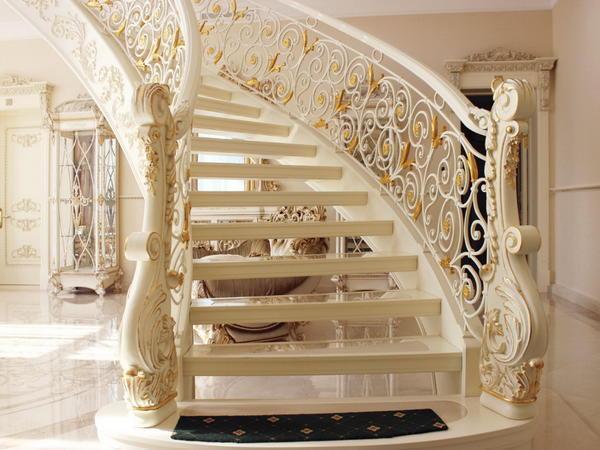
Types of varnishes and their main properties:
- Alcoholic - easy to apply, after drying they are highly resistant to damage. Such products must be applied in several layers. Their main disadvantage is low water resistance.
- Alkyd - after their application, a hard, transparent film forms on the surface. Alkyd varnish is water resistant and ideal for both indoor and outdoor staircases.
- Oil - have low resistance to external factors, so it is better to use them for interior painting. After drying, such varnishes form a hard layer with a yellowish tint on the surface of the object to be painted.
- Acrylic - give the wood a certain color.
- Nitrocellulose - dry quickly, used indoors.
- Polyester - after drying, they form a dense, hard film that needs to be polished. Resistant to water and other influences.
- Polyurethane - have a high cost due to their strength, wear resistance and environmental friendliness.
- Epoxy - resistant to alkali, water and mechanical damage.
- Polyurethane - have a high cost due to excellent strength, wear resistance and environmental friendliness.
- The oil is an environmentally friendly wax-based product that is perfectly absorbed, easy to apply, and has no nasty smell. And also oils have bactericidal and water-repellent properties, after drying they are especially strong and durable.
The durability and quality of painting, as well as the safety of the material, depends on the correctness of the chosen varnish.
Choice of paint and varnish
How to paint a pine staircase? Or, if your choice is lacquer, how to lacquer it?
It is worth dividing the working surface of the steps and all other elements of the staircase: they have completely different operating modes. The steps are subject to severe wear and tear; in addition, pine, as we remember, is a species with a low wood density. Studs or stiff heels may well leave marks on it with a low strength of the protective layer.
On the other hand, handrails and accessories for stairs (bowstrings, balusters) and the back of the steps are practically not subjected to loads. Any coating will perform mostly decorative functions - of course, in addition to protection from decay and moisture.
Hence the choice of materials:
- For the working surface of the steps, alkyd-based floor enamels are used - domestic PF-266 and imported analogues. Brand preferences are deeply subjective, so we will not name specific names to avoid accusations of hidden advertising.
- The best varnish for a pine staircase (more precisely, for the surface of the steps) is polyurethane parquet. Its price is quite high; instead, it forms an extremely durable and wear-resistant surface.
Tip: it is better to prefer not glossy, but matte or semi-matt varnish. There are less visible signs of wear on it, which will inevitably appear in the center of the steps, even if after a long time.

Accessories for stairs: types and purpose
For surfaces that are not exposed to intense mechanical stress, we can again recommend PF-115 alkyd enamels for outdoor use. they are weather resistant but not suitable for floor painting. With varnishes it is even easier: inexpensive nitrocellulose varnishes of the NT series or alkyd PF-170 will fully satisfy our requirements.
Painting a wooden staircase made of pine
A staircase made of pine differs from products from other types of wood in that it needs additional processing before painting, or rather, the product must be degummed.
A number of manipulations should be carried out for the following reasons:
- The resin that protrudes from the wood creates a film on the surface. Because of it, the paint layer does not penetrate into the fibers, which can affect the state of the ladder during operation.
- The areas where the resin is released will darken over time and look unaesthetic.
- A tarry mark on the surface is difficult to cover with paint. Varnish and other products lie unevenly, painting has a poor-quality result.
Deresinization of wood
For these works, you will need all kinds of solvents.
How to proceed:
- Apply the product to the surface of steps and railings with a brush.
- After processing, wipe the surface with warm water.
- Leave until the product is completely dry.
After the procedure, the wood is ready for painting.
How to paint a pine staircase?
- Enamel dyes are considered the best option for processing pine staircases.
- In diluted form, when applied to wood, the structure of the wood species will remain visible.
- If an undiluted mixture is used, the paint will completely hide the structure.
- Before applying paint to the surface, the stairs must be cleaned of dust and debris.
- Alkyd paints are easy to apply and dry quickly.
- Pigmented dyes perfectly hide defects and chips on the steps.
- Urethane - alkyd liquids are suitable for use on boards that have already been painted.
Varieties of paintwork
To give the staircase a finished look, several types of paints and varnishes are used. These are varnishes, impregnations and paints proper. The former emphasize the structure of the wood (toning) or fix the result (transparent), the latter also emphasize the beauty of the wood pattern, but need additional fixing with transparent varnish.Paints allow you to paint the stairs as you like.
Coloring is done not only for aesthetic purposes. Pine grooved board is most often used on the floor. Despite its strength, unopened wood wears out 5 times faster. This is due to the fact that dust and grains of sand are clogged into the pores, which over time destroy the structure of the floorboards. Opening a staircase made of pine or any other wood with varnish or paint with your own hands, you extend its service life.

Stain
Stain is one of the cheapest compounds for covering stairs. Impregnation comes in different colors. It is designed to protect wood and give it a certain shade. But it is better not to cover the stairs only with stain - after drying, you should use varnish.
It is customary to use a primer before applying varnish or paint, as it improves adhesion to the wood and makes the structure of the wood more uniform. If the primer is slightly tinted, then the characteristic woody pattern can be emphasized. Also, the primer contains substances that prevent the tree from rotting.

Transparent / tinting varnish for wood
The steps, balusters and railings are covered with varnish. Colorless composition does not hide the texture of the wood
It is very important that the sanding of all elements of the staircase is performed at the highest level. Transparent varnishes are of several types:
- Latex. Non-toxic material, safe for humans and animals. When applied to wood, forms a thin, durable, water-resistant layer. Has antiseptic properties - protects wood from mold and rot. It is used both indoors and outdoors.
- Water based or acrylate. It does not have an unpleasant odor, is non-toxic, forms a sufficiently strong coating that is resistant to mechanical damage, and prevents aging of the tree.
- On synthetic resins. Such varnishes dry quickly, are resistant to aggressive media (alkalis, acids), and are used only for interior work. Do not use synthetic resin varnishes to paint the stairs. For balusters and railings, they are suitable.
- Yacht. There are different types, depending on the base - alkyd and its varieties (urethane-alkyd, alkyd-urethane) and acrylate. It is toxic, so when using it inside the living area, wear a respirator, otherwise the probability of poisoning is 99%.
Advice! Use yacht colorless lacquer to paint stairs only as a last resort. It is poisonous even after drying.
Tinted varnishes include oil formulations. With their help, you can change the color of the tree from pale yellow to deep brown. When choosing, you need to see how many percent of the oil is included in the composition. For staining stair steps, this parameter should be at least 65%. In this case, you will get a durable, wear-resistant coating. If the oil varnish contains only 50% oil or less, there can be no question of any strength. This composition is only suitable for balusters and railings.

Wood paints
On sale you can find a great variety of very different compositions. But which one is suitable for painting a wooden staircase? To answer this question, you need to consider the types of paints used for wood:
Advice! Alkyd wood paints give consistently good results. Choose them if you want to save a little and get a high-quality staircase covering.
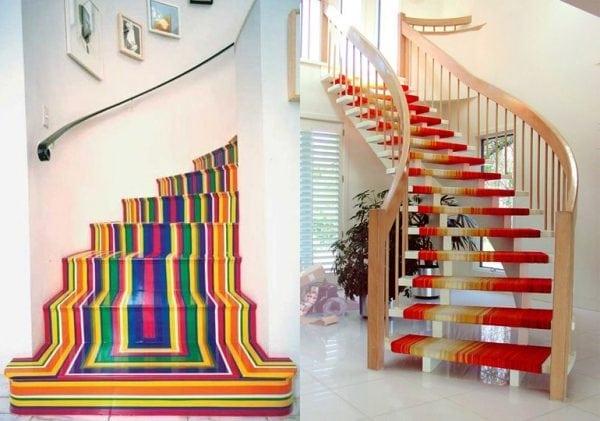
Staircase Paste
The paste is considered an unconventional type of coating. It consists of linseed oil and beeswax. The consistency of the paste depends on the hardness of the wood. If the wood is hard, then there should be four times more linseed oil than wax. For soft rocks, take two parts oil for one part wax. You can make the pasta yourself or buy it from the store.
The surface treatment is quite simple: the paste is simply rubbed in, for this you need to use a natural lint-free fabric - this will make the surface of the stairs a little matte, with a silky sheen.

